Guatemala is home to a wide variety of birds, from bright parrots to colorful hummingbirds and majestic raptors. With more than 700 species of birds, Guatemala is one of the top birding destinations in the world.
Its location in Central America and its diverse terrain, from tropical jungles to mountain highlands, provide a perfect habitat for an incredible array of birds. From the majestic quetzal to the iconic toucan, the birds of Guatemala are sure to delight and astound birders of all levels.
1. Resplendent Quetzal
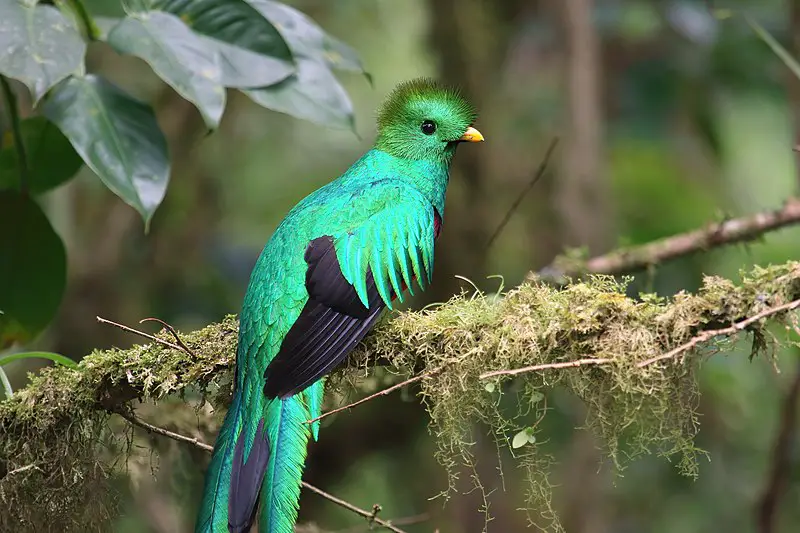
The resplendent quetzal is a beautiful and vibrant bird found in Central America. It belongs to the family Trogonidae, which includes birds like trogons and motmots.
This species of quetzal has two recognized subspecies: P. mocinno and P. costaricensis, both living in tropical forests such as montane cloud forests.
They are omnivores, typically eating fruits from various plants along with insects, lizards or eggs when available.
The male’s plumage is particularly striking with its multi-colored feathers ranging from green to blue to red that gives it its namesake “resplendence” look.
This coloration comes at a price for males because their bright colors make them more visible predators than females who have duller brown coloring instead.
Regardless of gender though all members of this species demonstrate great agility in flight due to their long tails which help stabilize them even through tight turns.Scientific classification:
| Kingdom | Animalia |
| Phylum | Chordata |
| Class | Aves |
| Order | Trogoniformes |
| Family | Trogonidae |
| Genus | Pharomachrus |
| Species | P. mocinno |
Also Featured In: Birds That Live in the Jungle, Rainforest Birds You Should Know
2. Pink-Headed Warbler
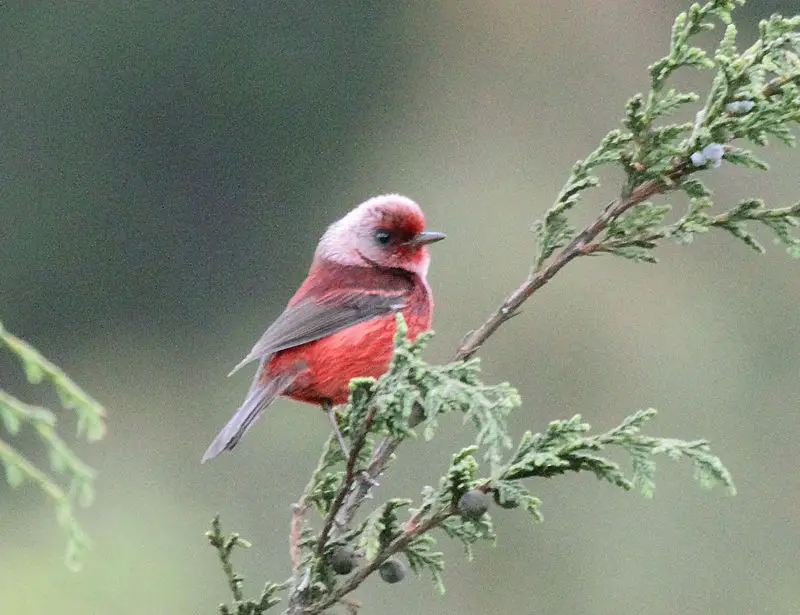
The Pink-headed Warbler is a small passerine bird found in Guatemala’s southwestern highlands and Mexico’s central and southeastern Chiapas state.
It has an eye-catching plumage, with its head and chest being silvery pink while the rest of its body primarily red.
This beautiful warbler makes humid to semi-humid pine-oak, pine evergreen or evergreen forests and edges at altitudes ranging from 7600 to 8700 feet their home.
They are fairly common inhabitants of these areas though they can be hard to spot due to their size.
Their diet consists mostly of insects making them important players in controlling insect populations that could cause major damage if left unchecked.Scientific classification:
| Kingdom | Animalia |
| Phylum | Chordata |
| Class | Aves |
| Order | Passeriformes |
| Family | Parulidae |
| Genus | Cardellina |
| Species | C. versicolor |
3. Trogon
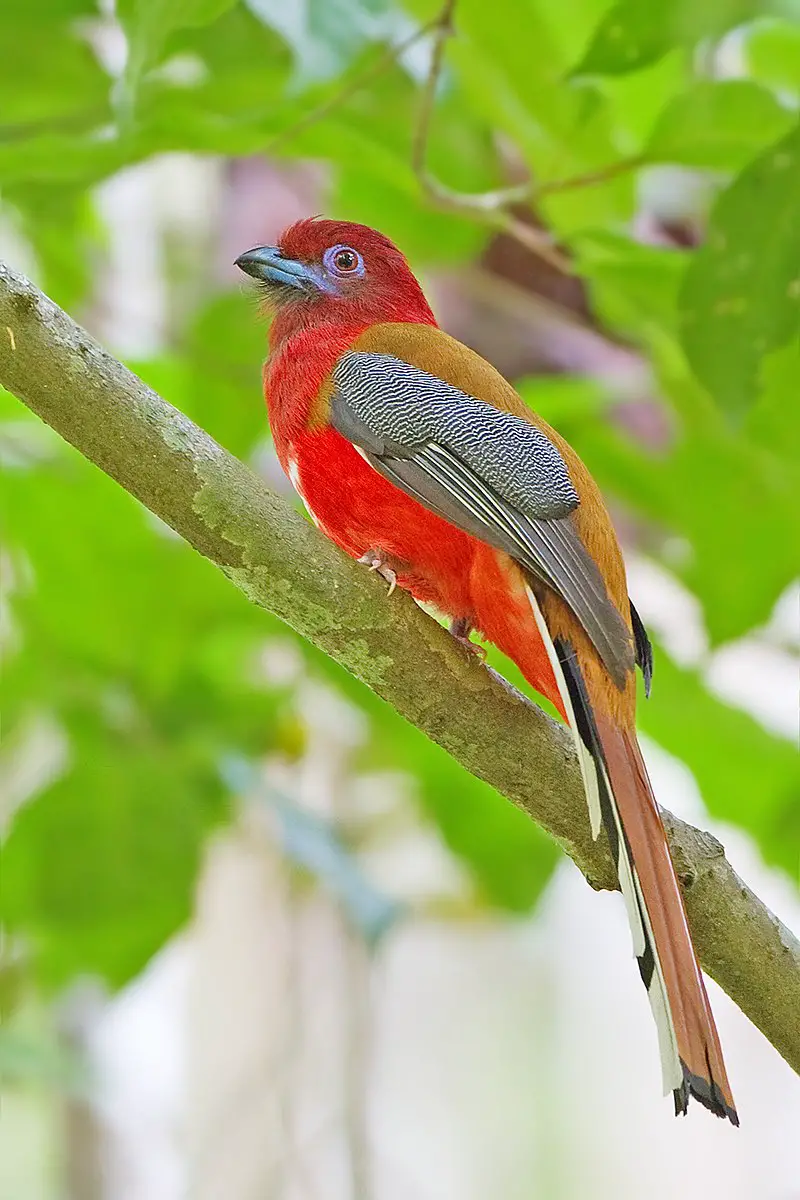
Trogons are a unique bird species that can be found all over the world. They belong to the order Trogoniformes and have only one family, called Trogonidae, which consists of 46 species in seven genera.
Fossil records show that trogons existed 49 million years ago during the Early Eocene period. It is believed they may be closely related or form part of two other orders: Coraciiformes and Passerines.
These birds typically have brightly colored feathers with some having iridescent colors on their wings and tails as well as red bellies and breasts.
Their diet mainly consists of fruit, insects, lizards and frogs but larger ones will also feed on small mammals such as mice or bats.
The most famous member from this group is Quetzalcoatlus – an extinct giant pterosaur which lived approximately 70-65 million years agoScientific classification:
| Kingdom | Animalia |
| Phylum | Chordata |
| Class | Aves |
| Clade | Cavitaves |
| Clade | Eucavitaves |
| Order | Trogoniformes AOU, 1886 |
| Family | Trogonidae Lesson, 1828 |
4. Ocellated Turkey
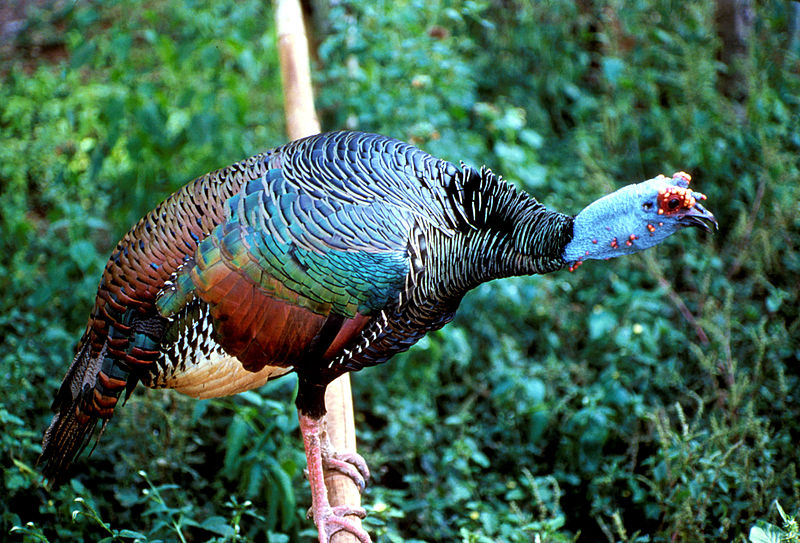
The ocellated turkey is a species of turkey found in the Yucatán Peninsula, Mexico as well as parts of Belize and Guatemala.
It is closely related to North American wild turkeys but there are slight differences between them that have led those studying these birds to keep them within separate genera.
The ocellated turkey has stunning plumage with an iridescent green head and neck, blue-green wings and tail feathers marbled with purple, bronze and gold hues.
They possess large eyespots on their tails which give this bird its name – ‘ocellate’ meaning eye or eyeball shaped spot.
These beautiful creatures typically live in forests where they feed on fruits, insects, seeds and other plant material.Scientific classification:
| Kingdom | Animalia |
| Phylum | Chordata |
| Class | Aves |
| Order | Galliformes |
| Family | Phasianidae |
| Genus | Meleagris |
| Species | M. ocellata |
5. Pharomachrus
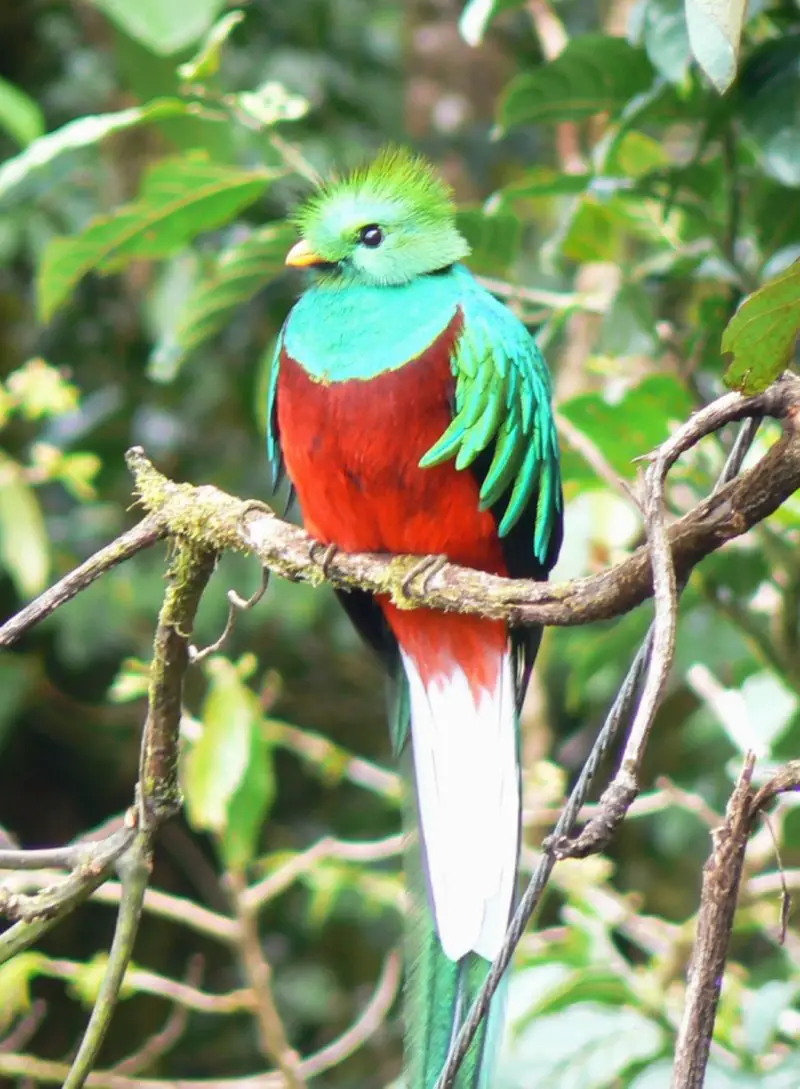
Pharomachrus is a genus of birds belonging to the Trogonidae family. These strikingly colorful creatures are commonly known as quetzals, and comprise of five species in this single genus.
Its name originates from Ancient Greek words ‘pharos’ meaning mantle, and ‘makros’ which means long – referring to its wing coverts that appear like mantles when fully spread out.
The Eared Quetzal is the only surviving member of the related but distinct Genus Euptilotis, making it one among these six beautiful avian jewels found mostly in Central America and parts of Southwestern North America.Scientific classification:
| Kingdom | Animalia |
| Phylum | Chordata |
| Class | Aves |
| Order | Trogoniformes |
| Family | Trogonidae |
| Genus | Pharomachrus de la Llave, 1832 |
6. Keel-Billed Toucan
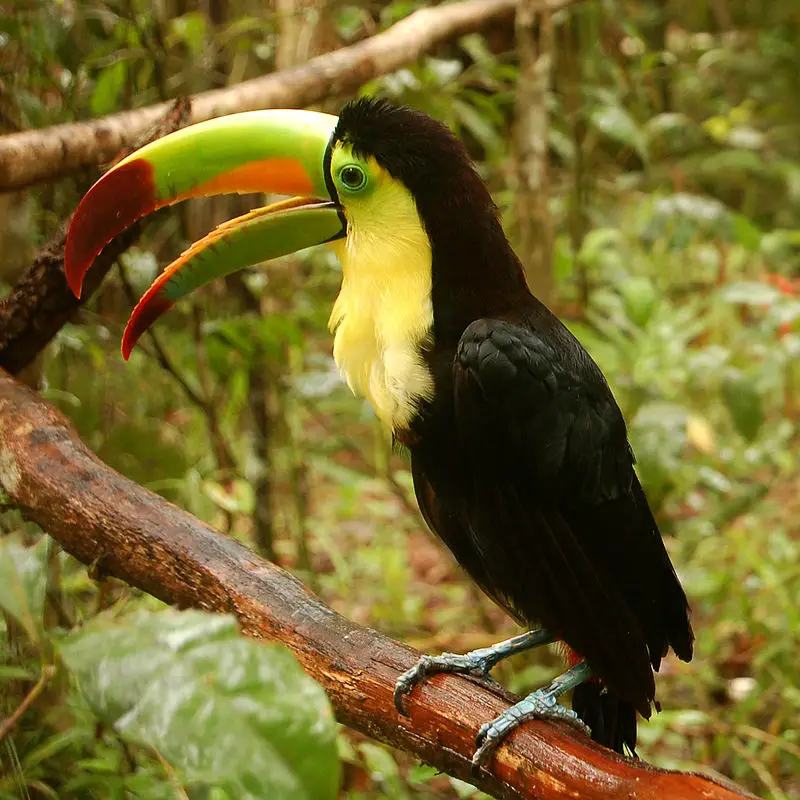
The Keel-billed Toucan is a vibrant Latin American bird from the toucan family and also serves as Belize’s national bird. They are found in tropical jungles stretching all the way from southern Mexico to Colombia.
They feed on fruits, seeds, insects, lizards and snakes – being omnivorous birds they eat pretty much anything.
These colourful creatures have an impressive beak with green upper parts of their bodies coupled with yellow lower halves.
The underside of their tail feathers are black while its tips remain white creating for quite a stunning display when flying or perched atop tree branches.Scientific classification:
| Kingdom | Animalia |
| Phylum | Chordata |
| Class | Aves |
| Order | Piciformes |
| Family | Ramphastidae |
| Genus | Ramphastos |
| Species | R. sulfuratus |
7. Belted Flycatcher
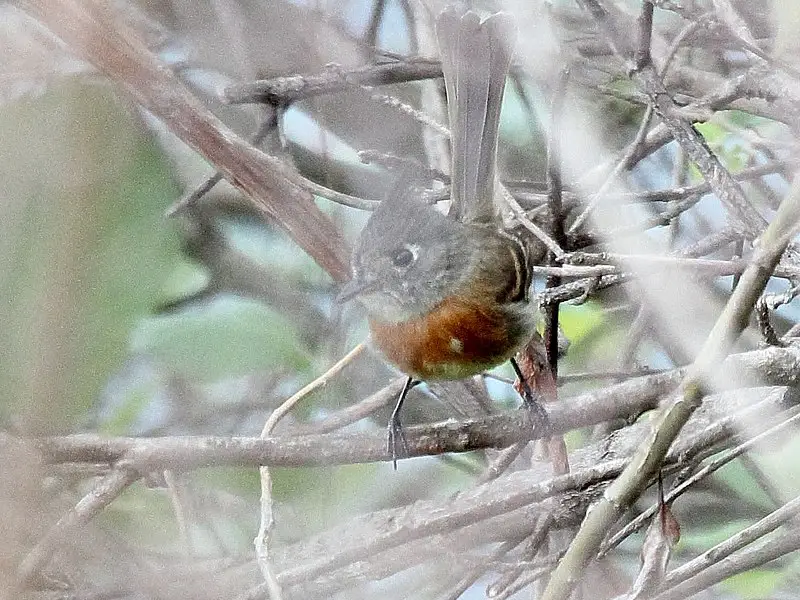
The belted flycatcher is a species of bird found in southern Mexico, Guatemala and El Salvador. It has a relatively dull appearance with light brown upperparts and dull yellow underparts.
Its crest is the most colourful feature, as it stands out against its muted colours; other features include pale eye-rings, cocoa coloured wing bars and chest bands.
Unfortunately this species is threatened by habitat loss due to human activity such as deforestation.
Therefore conservation efforts are needed to ensure that these birds can continue living in their native habitats for years to come.Scientific classification:
| Kingdom | Animalia |
| Phylum | Chordata |
| Class | Aves |
| Order | Passeriformes |
| Family | Tyrannidae |
| Genus | Xenotriccus |
| Species | X. callizonus |
8. Bearded Screech Owl

The Bearded Screech Owl is a small owl species found in Guatemala and Mexico. It was first described by Philip Sclater and Osbert Salvin in 1868, belonging to the subfamily Striginae of genus Megascops, making it monotypic.
Its specific epithet barbarus is derived from its type locality Santa Bárbara, Vera Paz. This nocturnal creature has long brown-grey feathers with white spots on its wings; dark eyes that can be seen through facial disc patterned with blackish-brown streaks below each ear giving it an apearance of having a beard hence earning the name ‘Bearded’ screech owl .
A unique yet majestic bird worth seeing.Scientific classification:
| Kingdom | Animalia |
| Phylum | Chordata |
| Class | Aves |
| Order | Strigiformes |
| Family | Strigidae |
| Genus | Megascops |
| Species | M. barbarus |
9. Blue-Throated Motmot
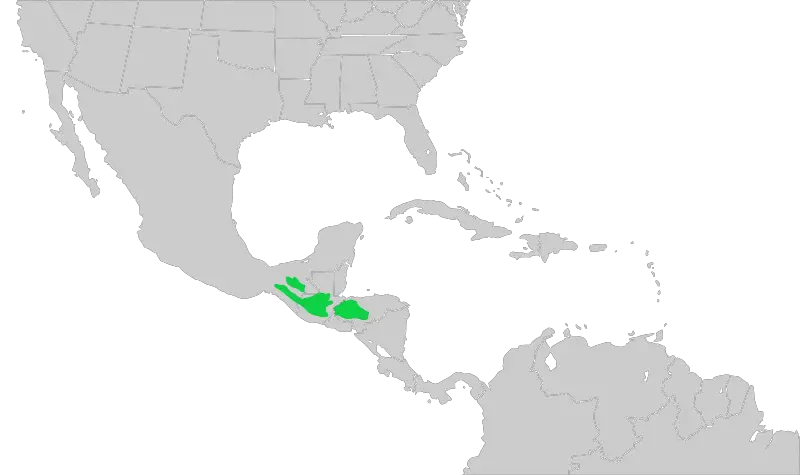
The Blue-throated Motmot is a unique bird found in El Salvador, Guatemala, Honduras and Mexico. It’s monotypic meaning it has no close relatives.
This stunning creature measures 25.5 to 28 cm long with a weight of 56 – 67 gm making them quite light for their size.
They are easily identifiable by their bright blue throat patch and green crown surrounded by black feathers that create an eye mask like effect on either side of the head.
The tail is also very distinct; being longer than most other birds with its two elongated central feathers trailing behind them as they fly or walk through dense vegetation searching for prey such as insects, lizards and small snakes.
All in all this beautiful species serves as reminder of the uniqueness our planet provides us with every day.Scientific classification:
| Kingdom | Animalia |
| Phylum | Chordata |
| Class | Aves |
| Order | Coraciiformes |
| Family | Momotidae |
| Genus | Aspatha Sharpe, 1892 |
| Species | A. gularis |
10. Azure-Rumped Tanager
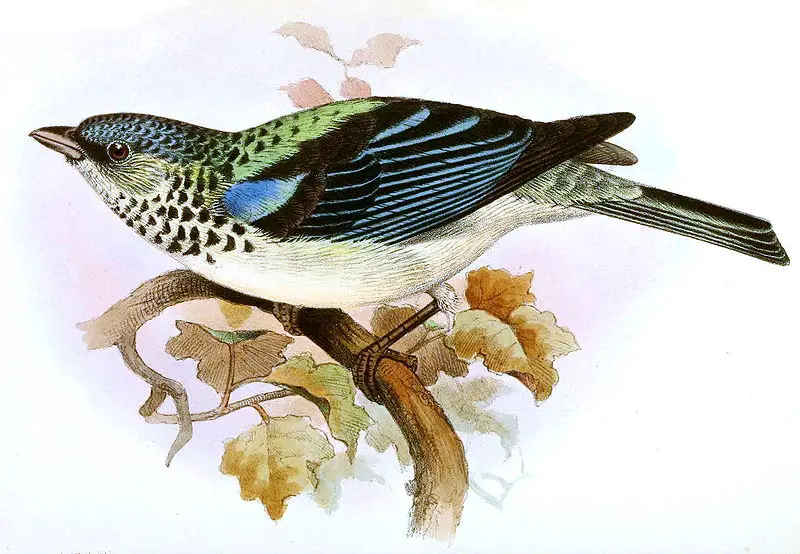
The Azure-rumped Tanager is a beautiful bird with mostly pale blue plumage and vibrant purplish-blue crown.
It can be found in humid broadleaf forests and adjacent plantations of the Pacific slope of western Guatemala and southern Chiapas, Mexico at elevations ranging from 850 to 1,900 meters.
This species is known for its strong vocalizations that are often heard just before dawn or after dusk.
The diet consists mainly of insects like beetles, moths and grasshoppers as well as fruits such as papaya, figs and bananas.
They form small flocks when feeding on ripe fruit but also feed alone during insect hunting expeditions.
Its bright coloring makes it an attractive addition to any backyard aviary.Scientific classification:
| Kingdom | Animalia |
| Phylum | Chordata |
| Class | Aves |
| Order | Passeriformes |
| Family | Thraupidae |
| Genus | Poecilostreptus |
| Species | P. cabanisi |
11. Wine-Throated Hummingbird
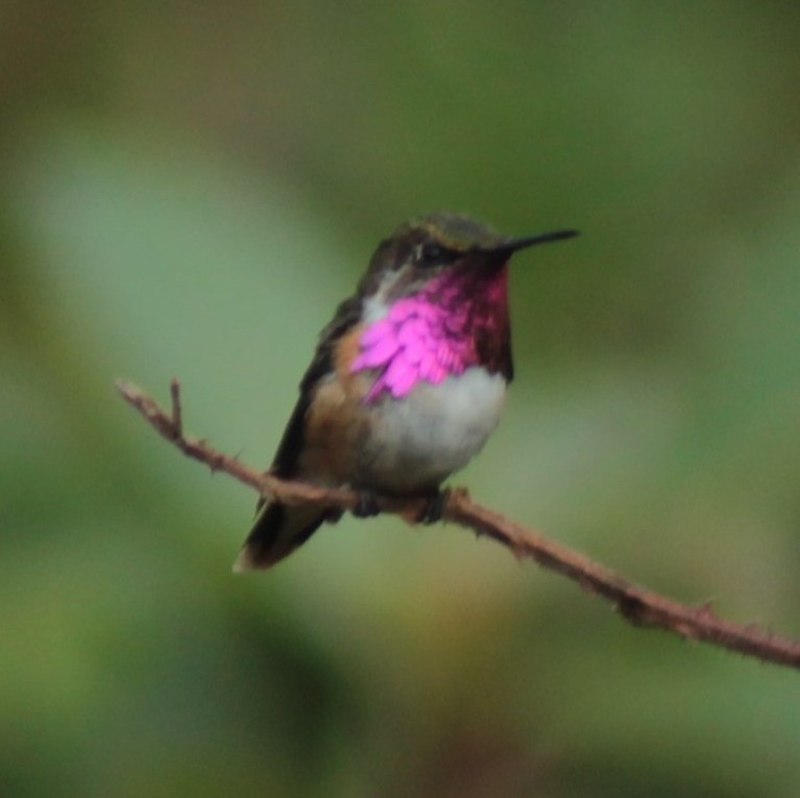
The Wine-throated Hummingbird is a species of hummingbird found in El Salvador, Guatemala, Honduras and Mexico. It belongs to the tribe Mellisugini in subfamily Trochilinae.
Its feathers are vibrant shades of green with an iridescent red throat patch that gives it its name; males also have some purple on their crowns and sides.
They feed mainly on nectar from flowers but occasionally eat small insects for protein.
These tiny birds measure just 7 cm long and weigh only 3 grams.
Their wings beat up to 80 times per second allowing them to move rapidly between flowers when looking for food or defending territory against rivals. A truly remarkable sight indeed.Scientific classification:
| Kingdom | Animalia |
| Phylum | Chordata |
| Class | Aves |
| Order | Apodiformes |
| Family | Trochilidae |
| Genus | Selasphorus |
| Species | S. ellioti |
12. Motmot
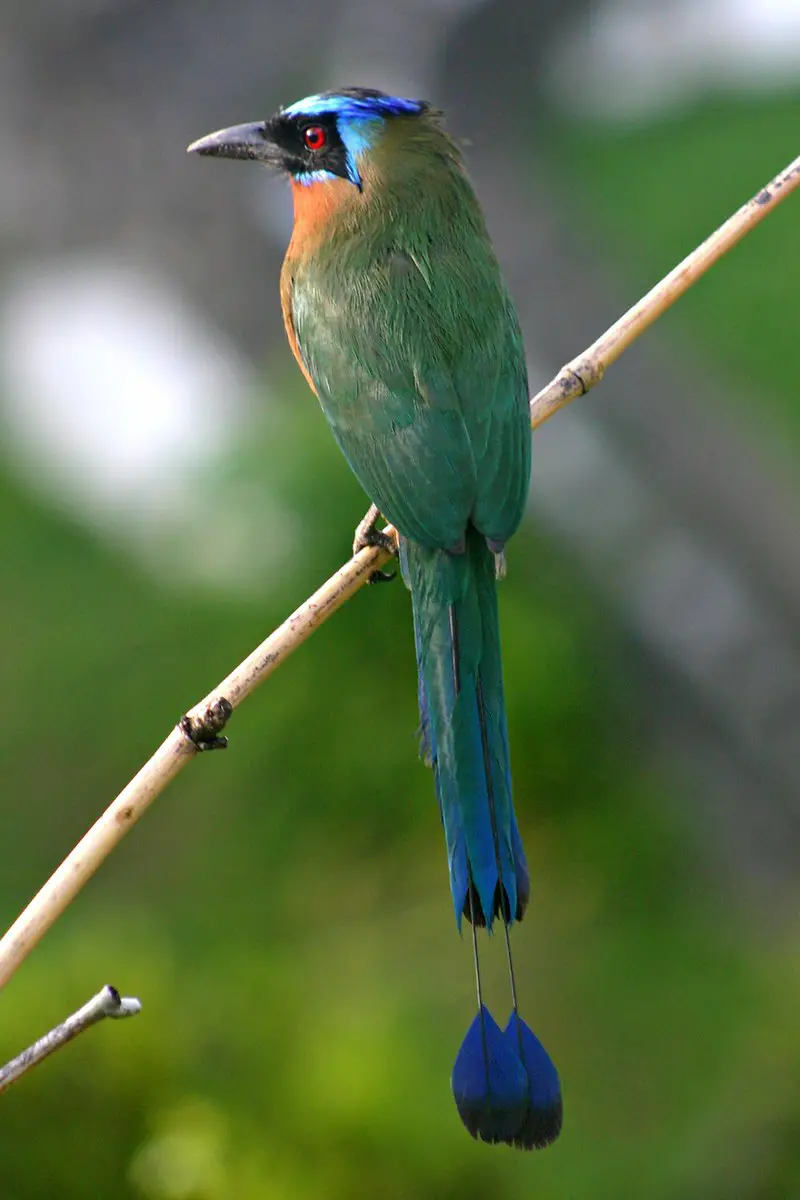
Motmots are a family of birds in the order Coraciiformes, known for their vibrant plumage and relatively heavy bills. They inhabit woodlands or forests across the Neotropics and can range in size from small to large.
The most distinctive feature of motmot species is their long tail feathers that some have adorned with unique patterns like eyespots.
Their diet consists mainly of insects but they will also eat smaller vertebrates such as lizards, frogs and fish.
Motmots are active during daylight hours where they can be seen perching on branches along forest edges or flitting through trees hunting prey.
These beautiful creatures have become an important part of many peoples’ lives throughout Latin America due to them being considered symbols of good luck by local cultures.Scientific classification:
| Kingdom | Animalia |
| Phylum | Chordata |
| Class | Aves |
| Order | Coraciiformes |
| Family | Momotidae GR Gray, 1840 |
13. Antbird
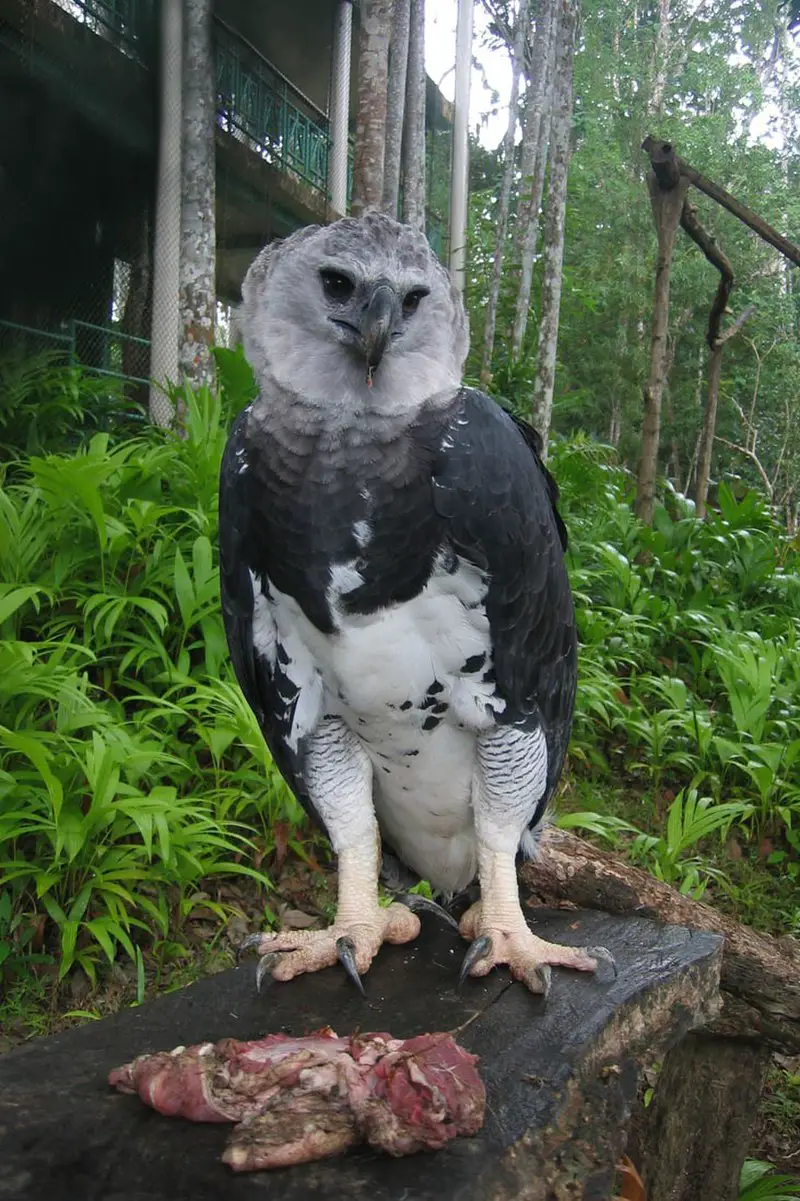
Antbirds are a large family of birds found in the Americas. They range from small to medium-sized and have long, thin bills for catching insects on or near the ground.
Antbirds also have strong legs with toes adapted for hopping around branches and foliage while searching for food.
These birds typically live in tropical forests where they feed mainly on insects such as ants, beetles, caterpillars, grasshoppers and spiders which they find by actively gleaning through leaf litter or probing into crevices among tree bark.
Their feathers tend to be dark browns, blacks and greys making them well camouflaged against their surroundings when perched amongst leaves or twigs waiting patiently to ambush unsuspecting prey.
In addition to feeding upon invertebrates some species will also occasionally consume fruits thus helping disperse seeds across the forest floor contributing towards regeneration efforts within many areas throughout South America
14. Puffbird
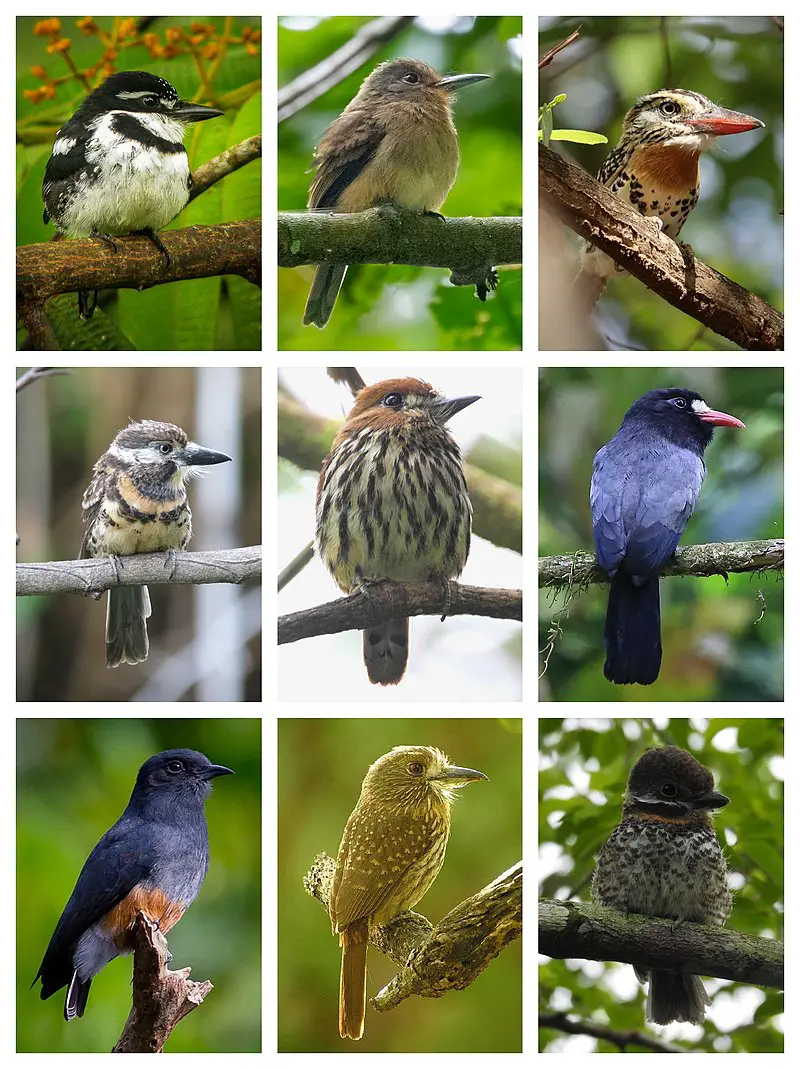
The Puffbird is a tropical tree-dwelling bird found in South America, Mexico and Central America.
It belongs to the near passerine family Bucconidae, which also includes jacamars – its closest relatives.
The order Piciformes unites these two families although some consider them separate under Galbuliformes.
Unlike other birds of the same group that have dazzling iridescent feathers, puffbirds are more modestly coloured with their greyish brown plumage blending into their environment for camouflage purposes when perched on trees or shrubs searching for insects as food sources using their long pointed bill.
They can be quite difficult to spot due to being small and well camouflaged but they may give away their presence by calling out loudly with an unmistakable whistling soundScientific classification:
| Kingdom | Animalia |
| Phylum | Chordata |
| Class | Aves |
| Order | Piciformes |
| Suborder | Galbuli |
| Family | Bucconidae Horsfield, 1821 |
15. Anhinga

Antbirds are a large family of birds found in the Americas. They range from small to medium-sized and have long, thin bills for catching insects on or near the ground.
Antbirds also have strong legs with toes adapted for hopping around branches and foliage while searching for food.
These birds typically live in tropical forests where they feed mainly on insects such as ants, beetles, caterpillars, grasshoppers and spiders which they find by actively gleaning through leaf litter or probing into crevices among tree bark.
Their feathers tend to be dark browns, blacks and greys making them well camouflaged against their surroundings when perched amongst leaves or twigs waiting patiently to ambush unsuspecting prey.
In addition to feeding upon invertebrates some species will also occasionally consume fruits thus helping disperse seeds across the forest floor contributing towards regeneration efforts within many areas throughout South America
16. Threskiornithidae
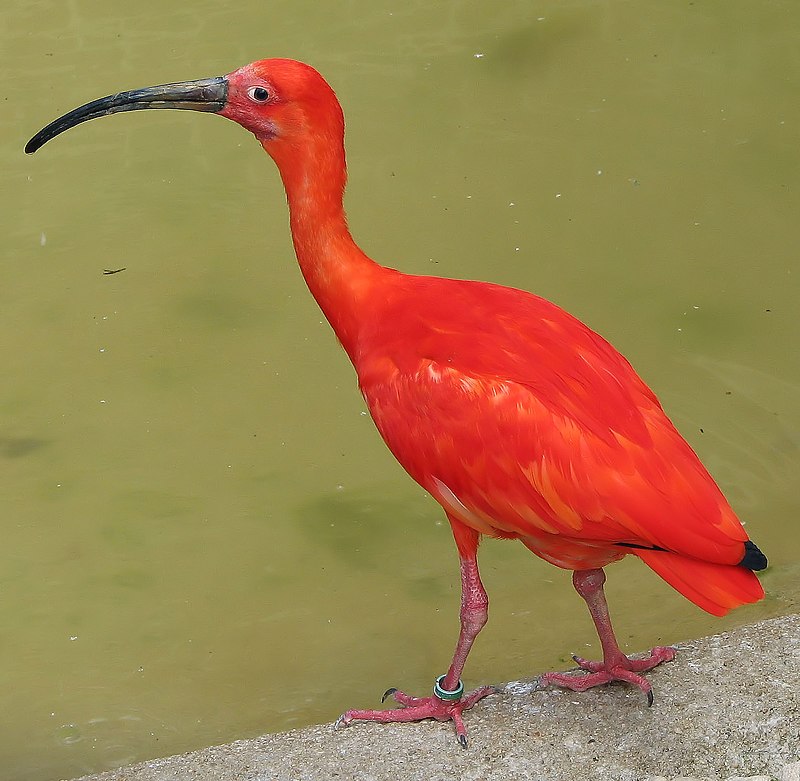
Threskiornithidae is a family of large wading birds which includes 36 species. These birds are traditionally divided into two subfamilies – the ibises and the spoonbills.
However, recent genetic analysis has shown that spoonbills actually belong to Old World ibis group, while New World ibises form an early offshoot from this lineage.
Threskiornithidse members have long curved beaks with serrated edges used for catching fish in shallow water or mudflats, as well as other aquatic invertebrates like crustaceans and mollusks.
They also feed on plant matter such as grains and seeds found close to wetlands areas where they live.
This diverse diet makes them important scavengers in their ecosystems, helping maintain healthy populations of native wildlife by controlling insect numbers and dispersing energy-rich seeds throughout wetland habitats.Scientific classification:
| Kingdom | Animalia |
| Phylum | Chordata |
| Class | Aves |
| Order | Pelecaniformes |
| Suborder | Ardei |
| Family | Threskiornithidae Richmond, 1917 |
17. Heliornithidae
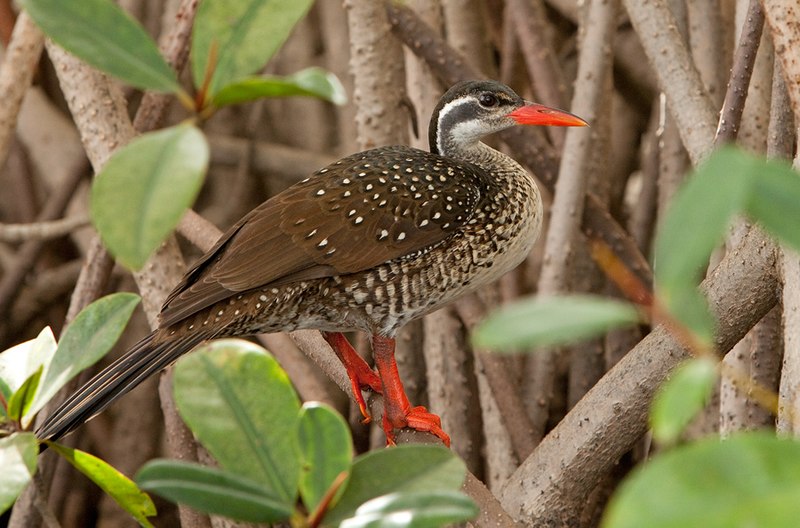
Heliornithidae, commonly known as finfoots, are a small family of tropical birds found in South America and Africa. They have webbed feet like grebes or coots, long necks, slender bodies and broad tails with sharp pointed bills.
Their diverse calls include whistles, squawks and croaks which they use to communicate with each other.
Finfoots feed mainly on fish but also consume insects such as water beetles and dragonflies near the surface of waterbodies.
They nest around rivers or lakes where there is plenty of cover from predators such as eagles or hawks.
During breeding season males can become quite territorial defending their territories against intruders by chasing them off aggressively using loud noises or even physical contact if necessary.Scientific classification:
| Kingdom | Animalia |
| Phylum | Chordata |
| Class | Aves |
| Order | Gruiformes |
| Family | Heliornithidae GR Gray, 1840 |
18. New World Quail
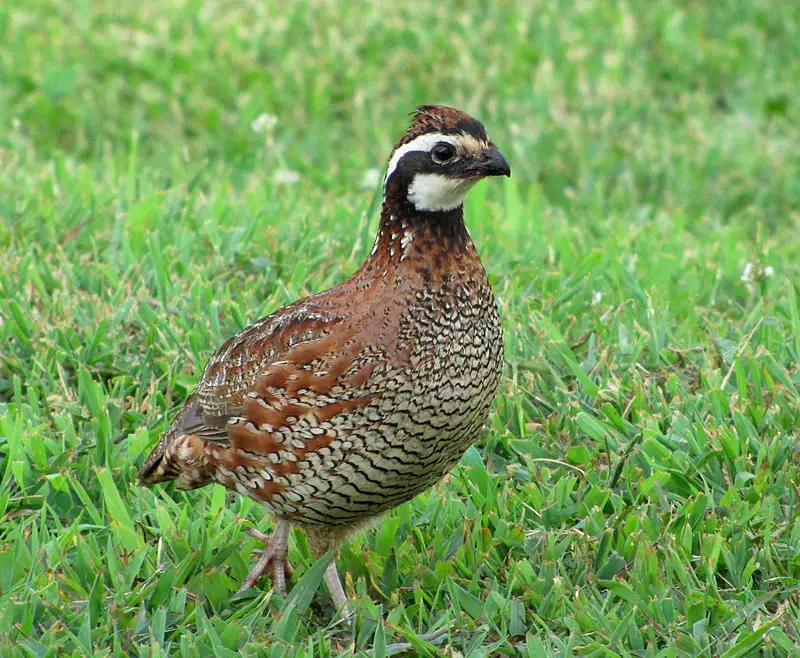
New World quail are small birds found in the Americas, from Canada to Brazil. They belong to their own family, Odontophoridae, and have similar appearance and habits as Old World quail which belong to a different family.
New World Quails come in various species such as California Quail and Bobwhite Quail.
These birds have adapted well to human presence due to availability of food resources like agricultural crops.
They also live close together where they form large flocks for safety against predators like foxes or hawks.
The males usually sport colorful feathers during mating season that helps them attract female mates while providing an amazing sight for us viewers.Scientific classification:
| Kingdom | Animalia |
| Phylum | Chordata |
| Class | Aves |
| Order | Galliformes |
| Superfamily | Phasianoidea |
| Family | Odontophoridae Gould, 1844 |
19. Jacamars
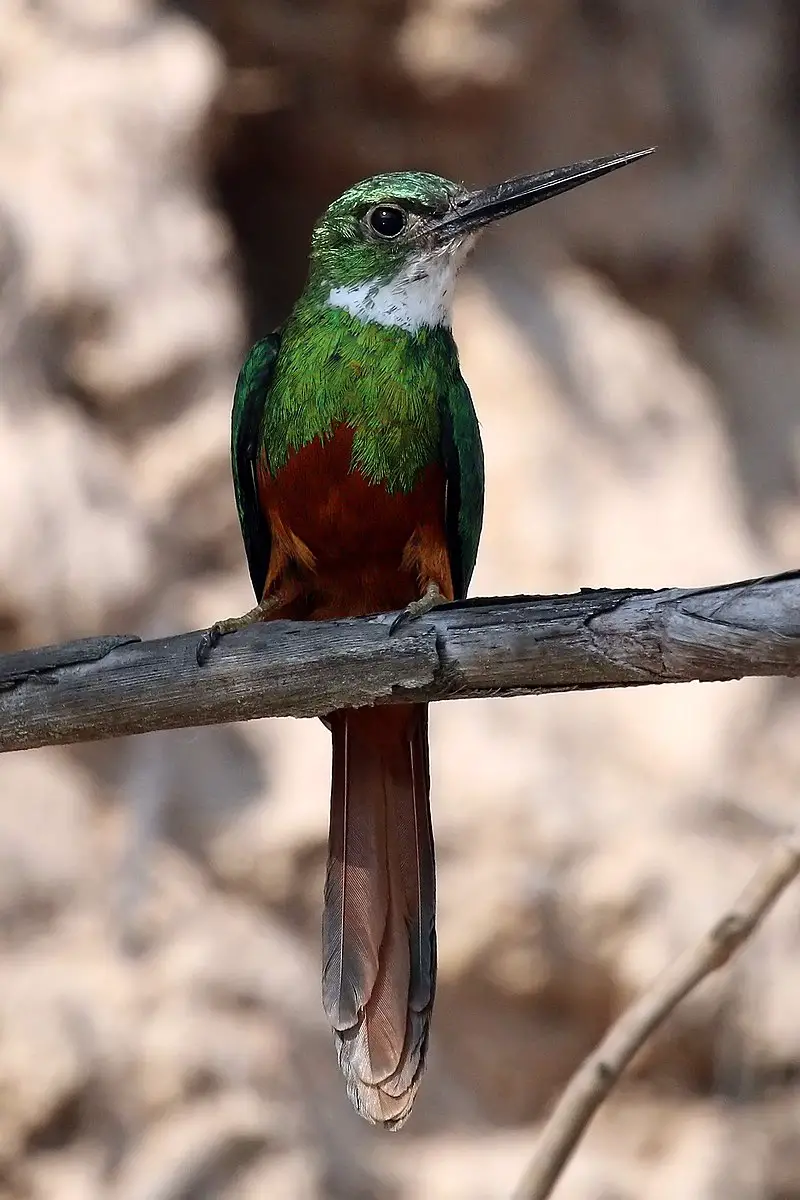
Jacamars are tropical birds native to South and Central America, extending as far north as Mexico. They belong to the Galbulidae family which consists of five genera and eighteen species in total.
These captivating birds can be easily distinguished by their unique appearance; they have long sharp bills with bright vivid plumage ranging from blues, greens and yellows that create a beautiful contrast against the lush vegetation of their natural habitat.
Jacamars prefer to inhabit dense forested areas near rivers or streams where they use their agile wings for quick flight maneuvers while hunting insects, lizards and frogs.
With an unmistakable presence these fascinating feathered creatures make a remarkable addition to any backyard bird sanctuary.Scientific classification:
| Kingdom | Animalia |
| Phylum | Chordata |
| Class | Aves |
| Order | Piciformes |
| Suborder | Galbuli |
| Family | Galbulidae Vigors, 1825 |
20. Plovers
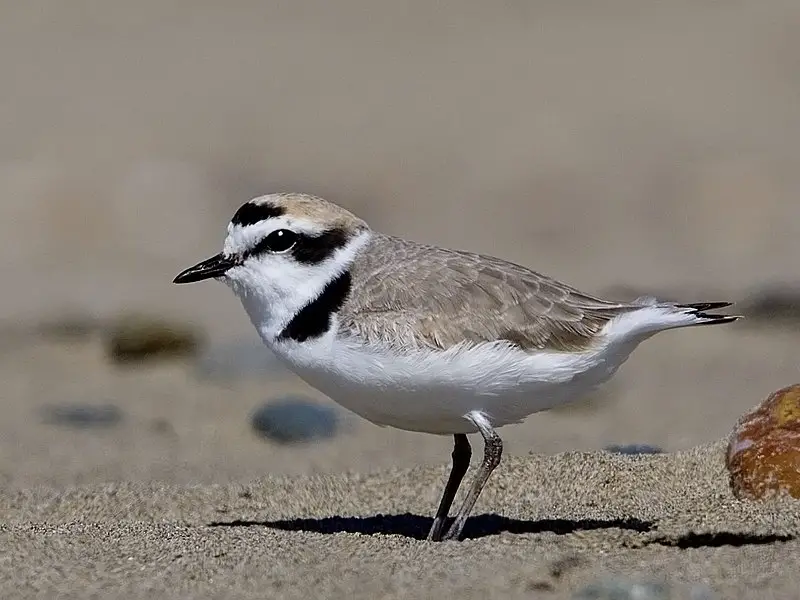
Plovers are a family of around 64-68 species of ground-dwelling birds, commonly found in open country such as fields, meadows and tundras.
They have short bills with webbed feet to help them forage through mud or shallow water.
Plover plumage is usually mottled brown though some species may have brighter colors on the head and wings.
These birds feed mainly on insects but can also eat small crustaceans and worms.
Plovers breed during springtime when they dig holes in sandy or pebbled beaches to lay their eggs which hatch after about 3 weeks incubation period.
They use distraction display behaviour by pretending an injury to the predators away from their nests if needed for protecting their young ones.Scientific classification:
| Kingdom | Animalia |
| Phylum | Chordata |
| Class | Aves |
| Order | Charadriiformes |
| Family | Charadriidae Leach, 1820 |
21. Stilts And Avocets
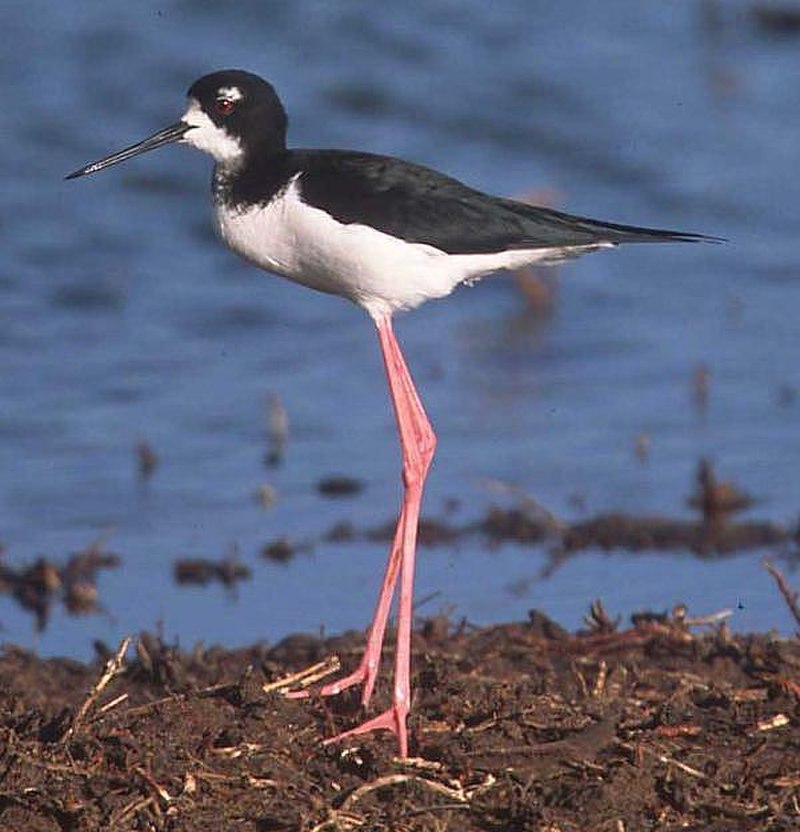
Stilts and avocets are two distinct groups of birds belonging to the family Recurvirostridae. They range in length from 30-46 cm (12-18 inches) and weigh between 140 – 435 g (4.9 – 15.3 ounces).
Males usually have slightly larger bodies than females, with long thin legs, necks and bills.
Avocet bills curve upwards uniquely while stilt beaks remain straight most times.
These wading birds live mainly near shorelines or wetlands where they feed on aquatic invertebrates like brine shrimp, insects etc., occasionally supplementing their diet with seeds or small fish too.
Stilts also inhabit open fields in search of food sources such as earthworms or grasshoppers during the non-breeding season.
Both groups migrate over large distances for warmer weathers when it gets cold outside.Scientific classification:
| Kingdom | Animalia |
| Phylum | Chordata |
| Class | Aves |
| Order | Charadriiformes |
| Suborder | Charadrii |
| Family | Recurvirostridae Bonaparte, 1854 |
22. Ruddy Crake
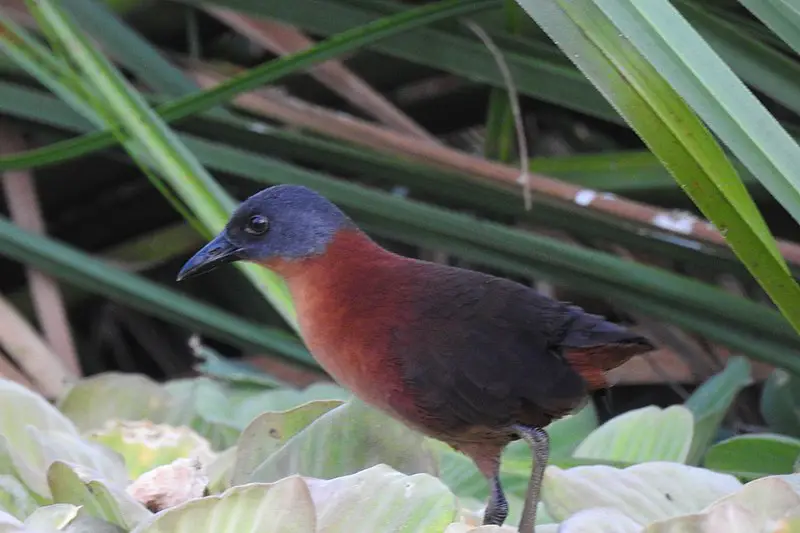
The Ruddy Crake is a beautifully vibrant bird that belongs to the Rail family. It has reddish-brown plumage, which can vary in shade and have a grey head with dark brown wings and tail.
Its crown is blackish while its ear coverts are light grey. The chin and belly of the bird are paler than other parts of it’s body.
This species doesn’t migrate but instead lives in wetland areas throughout South America including Argentina, Bolivia Brazil, Colombia, Ecuador Paraguay Peru Uruguay & Venezuela.
They feed on small invertebrates such as insects or crustaceans found near water sources like marshes or ponds making them very similar to their rail relatives who also inhabit these types of habitats.
All in all this beautiful red creature makes for an interesting sight when encountered out in nature.Scientific classification:
| Kingdom | Animalia |
| Phylum | Chordata |
| Class | Aves |
| Order | Gruiformes |
| Family | Rallidae |
| Genus | Laterallus |
| Species | L. ruber |
23. Berylline Hummingbird
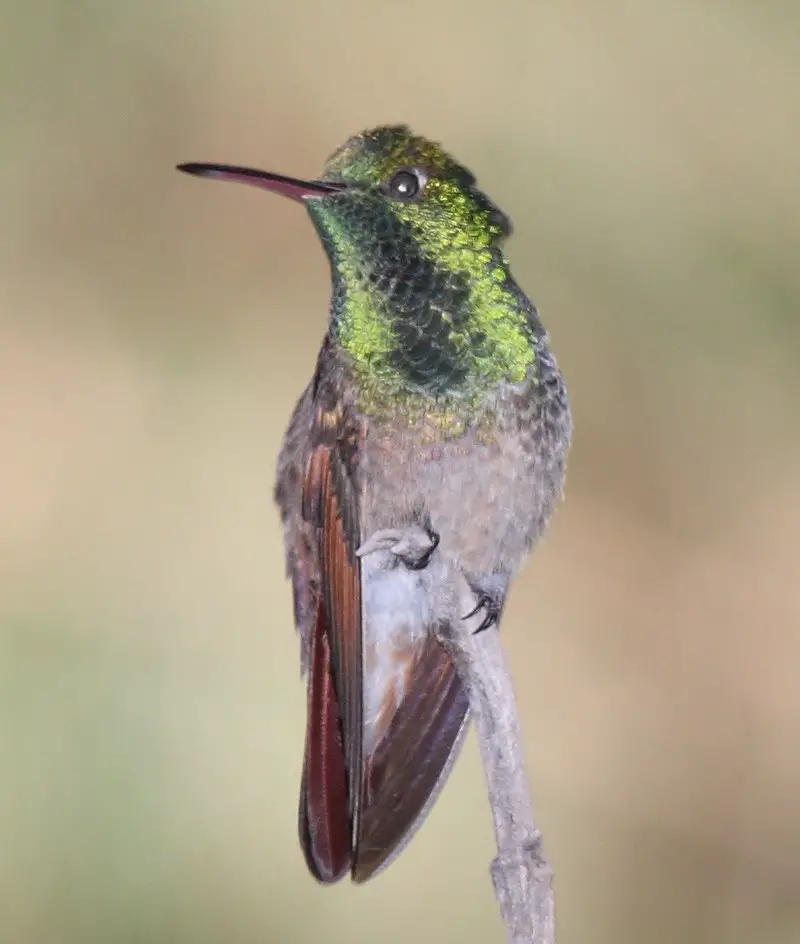
The Berylline Hummingbird is a vibrant species of hummingbird found in Central America and the United States.
It has emerald green upperparts, rufous sides and underparts, white tips to its tail feathers, as well as an iridescent purple throat patch.
These birds are highly territorial and will defend their territories against intruders with impressive aerial displays.
They feed on nectar from flowers such as bromeliads, columbines or agaves while searching for insects which they catch mid-air by hovering near foliage or flying low over meadows.
The Berylline Hummingbird is considered a Least Concern species due to its wide distribution range but it faces threats from habitat loss caused by urbanization and farming practices that reduce suitable nesting sites available for this bird.Scientific classification:
| Kingdom | Animalia |
| Phylum | Chordata |
| Class | Aves |
| Order | Apodiformes |
| Family | Trochilidae |
| Genus | Saucerottia |
| Species | S. beryllina |
Also Featured In: Puerto Vallarta Birds You Should Know, Green Birds in That Live in Texas
24. Black-Capped Siskin
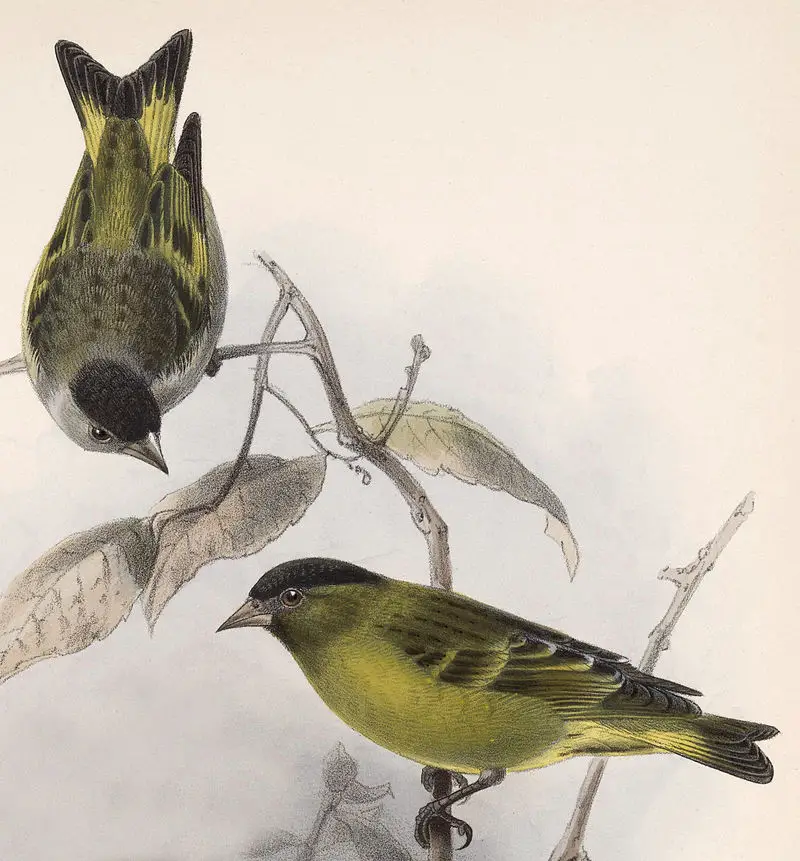
The Black-capped siskin is a species of finch found in Mexico and Guatemala. It inhabits subtropical or tropical moist montane forests and heavily degraded former forests.
With its gray wash color, it stands out with its distinct black cap on the head. Antonio Arnaiz-Villena et al have obtained specimens for scientific research purposes to further understand this species better.
This bird has been classified as a finch due to its structure similar to other members of the family Fringillidae such as canaries and goldfinches.
Although they are small birds, their presence enriches the ecosystem by helping disperse seeds through their feeding habits while providing food sources for larger animals like hawks who prey upon them occasionallyScientific classification:
| Kingdom | Animalia |
| Phylum | Chordata |
| Class | Aves |
| Order | Passeriformes |
| Family | Fringillidae |
| Subfamily | Carduelinae |
| Genus | Spinus |
| Species | S. atriceps |
25. Black-Throated Jay
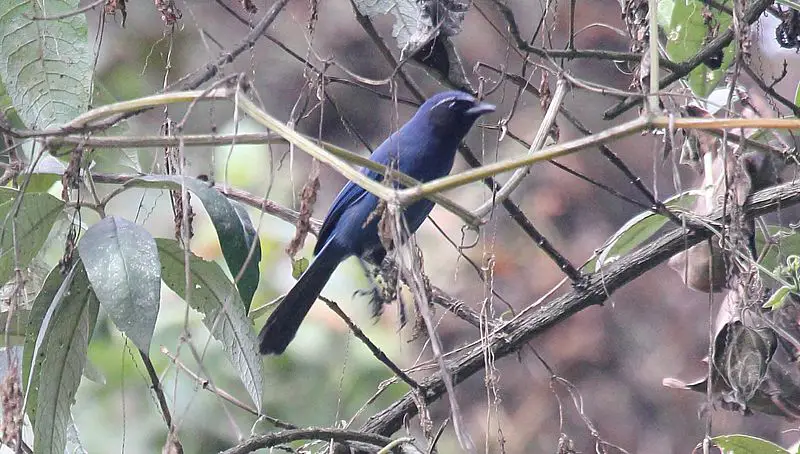
The black-throated jay is a beautiful bird found in the Central American countries of Chiapas, Guatemala and Honduras. It resides mainly in subtropical or tropical moist montane forests where it can find plenty of food sources to sustain itself.
The plumage on this species varies from blue to grey with hints of yellow around its neck and head area. Its diet consists mostly of small insects such as ants and beetles, but some individuals will supplement their meals by consuming fruits when available.
This species has adapted well over time to living among humans due to its intelligence which allows them take advantage of human-provided resources like scraps from picnic tables or gardens.
Conservation efforts have been made for these birds since they are considered endangered due to habitat loss caused by deforestation activities such as logging, agriculture conversion and urbanizationScientific classification:
| Kingdom | Animalia |
| Phylum | Chordata |
| Class | Aves |
| Order | Passeriformes |
| Family | Corvidae |
| Genus | Cyanolyca |
| Species | C. pumilo |
26. Pacific Parakeet
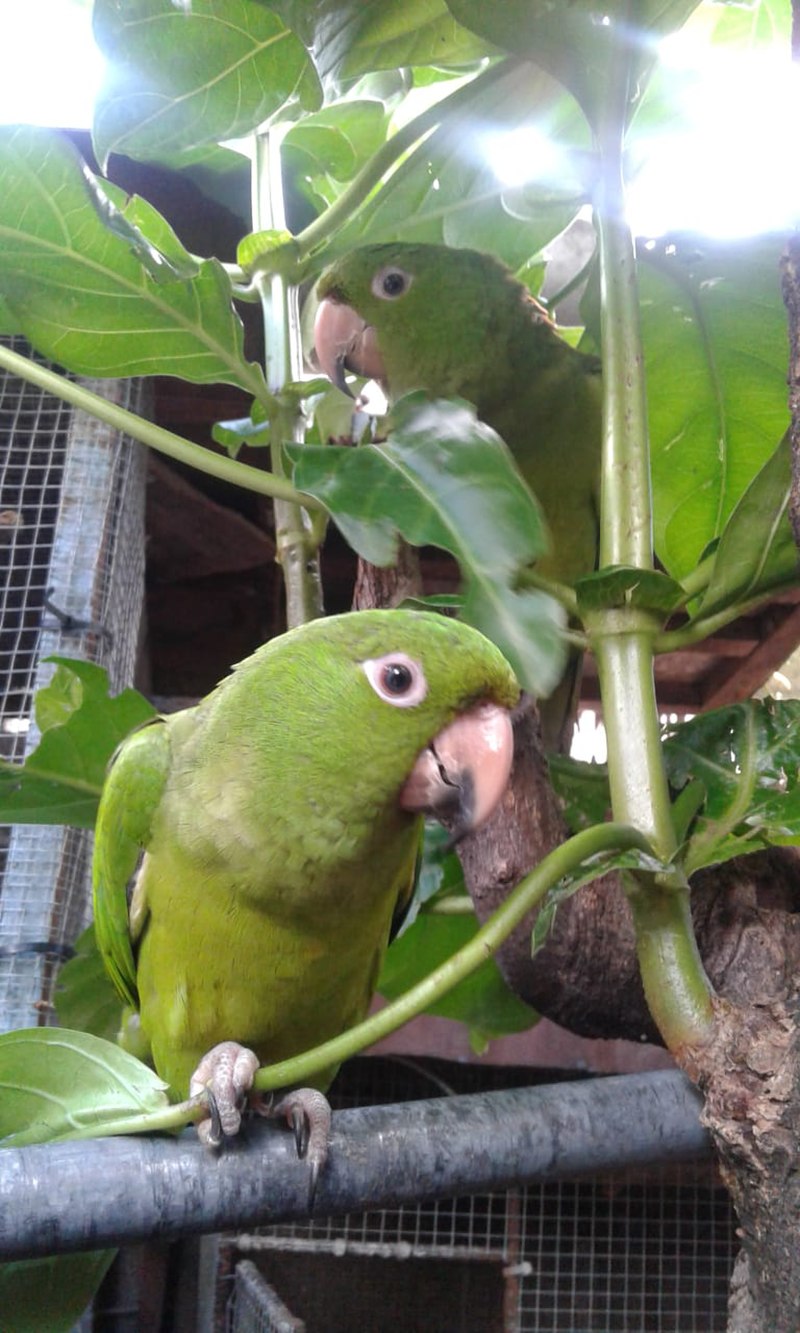
The Pacific parakeet is a species of parakeet that can be found in the Chocoyero-El Brujo Natural Reserve, located in western Nicaragua. It has bright green feathers with pale yellow stripes on its wings and tail.
This bird usually feeds on fruits, seeds, buds and blossoms from trees or shrubs.
The Pacific Parakeets mate for life and form flocks together to protect their nesting sites which are generally holes within tree trunks or branches near water sources such as rivers or lakes.
These birds have an average lifespan of 15 years but may live up to 30 years if well cared for in captivity.
They require plenty of open space along with hiding spots like boxes so they feel safe enough to explore their environment freely.Scientific classification:
| Kingdom | Animalia |
| Phylum | Chordata |
| Class | Aves |
| Order | Psittaciformes |
| Family | Psittacidae |
| Genus | Psittacara |
| Species | P. strenuus |
27. Silky-Flycatchers
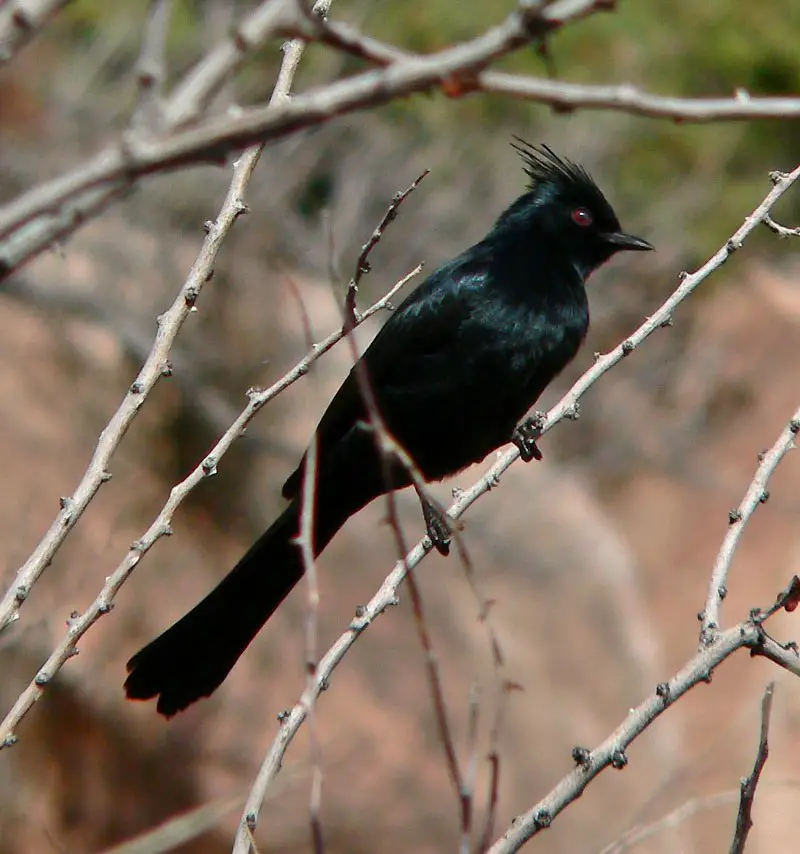
Silky-flycatchers are a small family of passerine birds, comprised of four species across three genera. They have silky plumage and use aerial flycatching techniques when hunting for food.
These birds might superficially resemble waxwings or hypocolius, with whom they were formerly grouped in the Bombycillidae family; however, Silky-flycatchers are not actually related to these other species.
The most distinguishing characteristics that set them apart from similar looking birds include their large eyes and strong bills which allow them to hunt successfully using their unique aerial tactics.
Some species also feature distinctive crests on top of their heads during breeding season as well as bright yellow throats among males only.Scientific classification:
| Kingdom | Animalia |
| Phylum | Chordata |
| Class | Aves |
| Order | Passeriformes |
| Superfamily | Bombycilloidea |
| Family | Ptiliogonatidae Baird, 1858 |
28. Galápagos Shearwater
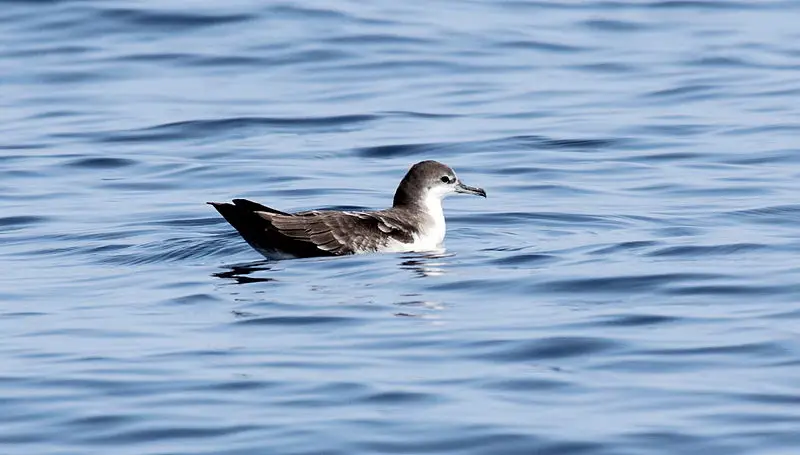
The Galápagos Shearwater is a small bird found only on the islands of the Galapagos archipelago. It was recently reclassified as its own species, distinct from Audubon’s Shearwater and Christmas shearwater.
It has an ancient lineage that dates back to before humans arrived in the area. The Galapagos shearwaters are endemic breeders, meaning they can be seen nowhere else on earth.
They have dark brown plumage with light underparts and white markings near their eyes and wingspan which ranges between 14 – 16 inches long allowing them to soar great distances across oceans while searching for food such as squid or fish.
This beautiful creature serves not just an aesthetic purpose but also plays a major role in keeping oceanic ecosystems healthy by controlling prey populations like flying fish.Scientific classification:
| Kingdom | Animalia |
| Phylum | Chordata |
| Class | Aves |
| Order | Procellariiformes |
| Family | Procellariidae |
| Genus | Puffinus |
| Species | P. subalaris |
29. Azure-Crowned Hummingbird
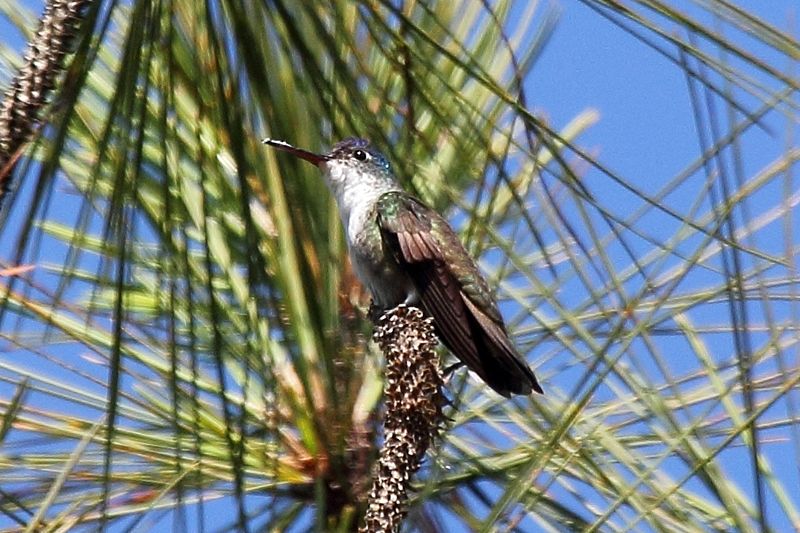
The Azure-crowned hummingbird is a species of the “emeralds” tribe Trochilini, found in Central America.
Its striking physical features include an azure crown and vibrant iridescent feathers that shimmer greenish blue when light reflects off them.
It was initially described as Ornismya cyanocephalus before being moved to its current genus Amazilia.
A molecular phylogenetic study published in 2014 showed it has close genetic ties with other emeralds such as the Green Violetear and Black-throated Mango hummers.
The bird feeds on nectar from flowers, small insects and spiders for protein, tree sap and even lizards.
This diet helps keep their metabolism high so they can stay active even during cold days or nights at higher altitudes where temperatures drop quickly after sunset.
With its beautiful colors and fascinating behavior these birds are a delight to watch wherever you may find them.Scientific classification:
| Kingdom | Animalia |
| Phylum | Chordata |
| Class | Aves |
| Order | Apodiformes |
| Family | Trochilidae |
| Genus | Saucerottia |
| Species | S. cyanocephala |
Also Featured In: Birds that You’ll Find in Chiapas,
30. Chestnut-Sided Shrike-Vireo
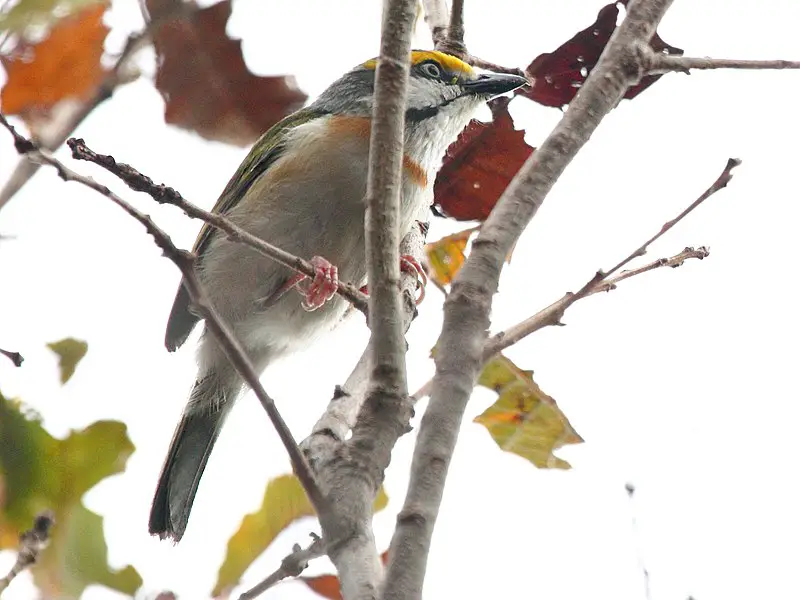
The Chestnut-sided Shrike-Vireo is a species of bird belonging to the Vireonidae family. It can be found in Guatemala and Mexico, inhabiting subtropical or tropical moist montane forests.
At 16.5 – 18 cm (6.5 – 7.1 inches) long and weighing 34.7 g on average (1 .22 oz), it’s one of the largest vireos known. This bird has an olive green upper body with yellow underparts and wings that are mainly blackish brown but have chestnut sides when viewed from afar hence its name; they also feature two white wing bars which make them easily identifiable even at a distance.
They primarily feed on insects as well as fruits during their migration period; they generally travel alone or in pairs within mixed flocks while migrating southward for wintering grounds each year.Scientific classification:
| Kingdom | Animalia |
| Phylum | Chordata |
| Class | Aves |
| Order | Passeriformes |
| Family | Vireonidae |
| Genus | Vireolanius |
| Species | V. melitophrys |
31. Slender Sheartail
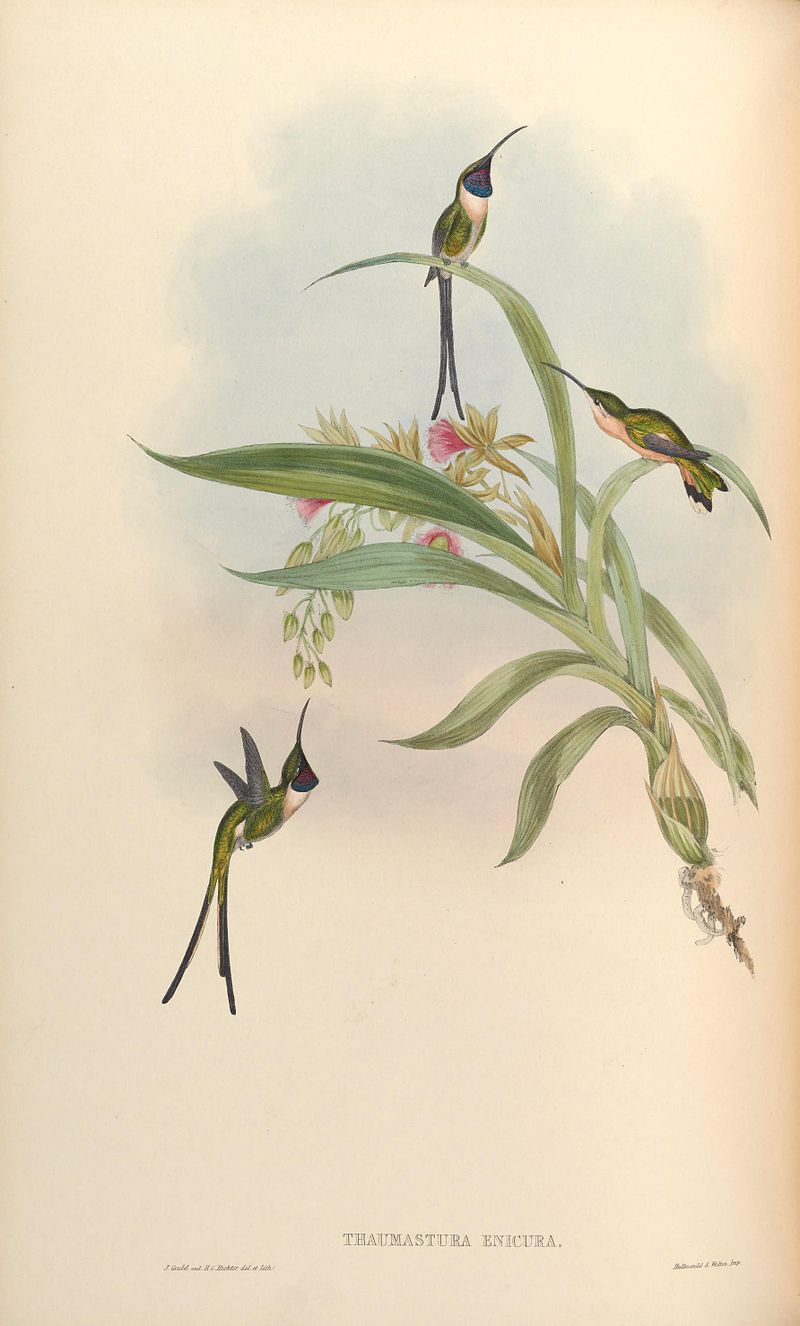
The Slender Sheartail is a species of hummingbird native to El Salvador, Guatemala, Honduras and Mexico. It belongs to the tribe Mellisugini in the subfamily Trochilinae – commonly referred to as bee-hummingbirds.
Males measure about 11-12.5 cm long and weigh 2.3g while females are slightly smaller at 10cm long with a weight of 1.8g respectively.
The slender sheartail shares its genus Doricha with another Mexican bird called the Mexican Sheartail (Doricha eliza).
Its coloration consists mainly of brown iridescent feathers on its back and wings as well as white underparts that contrast against it’s black tail which has two thin streamers or ‘shears’ giving this species their name; be sure not miss out viewing these delightful birds.Scientific classification:
| Kingdom | Animalia |
| Phylum | Chordata |
| Class | Aves |
| Order | Apodiformes |
| Family | Trochilidae |
| Genus | Doricha |
| Species | D. enicura |
32. Tawny-Winged Woodcreeper
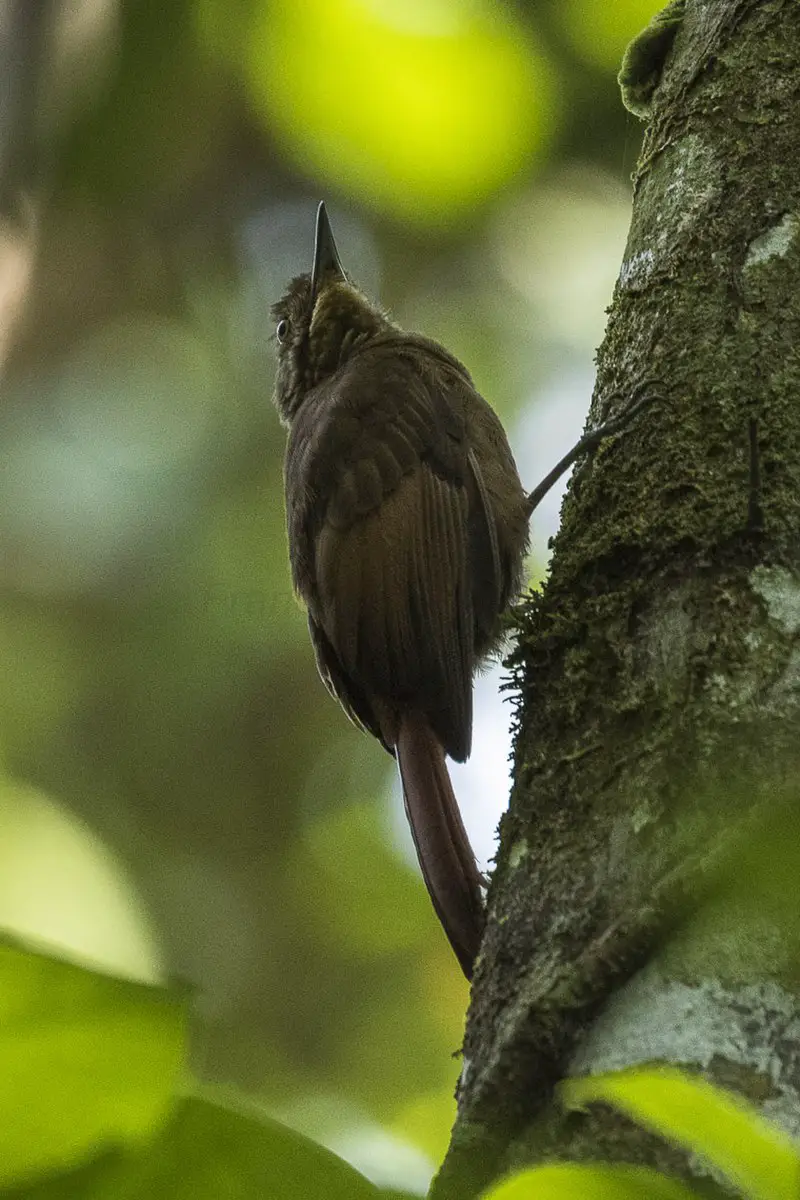
The tawny-winged woodcreeper is a species of bird belonging to the subfamily Dendrocolaptinae, which are found in New World forests. These birds can be seen in Central American countries such as Belize, Costa Rica, Guatemala, Honduras, Mexico and Nicaragua.
They live mainly in subtropical or tropical moist lowland forests where they feed on insects by probing with their bills into crevices or bark layers. Their feathers range from dark browns to light buff colors while its wings have two alternating bands of black and white stripes that give it its namesake coloration.
Woodcreepers grow up to 8 inches long and weigh about 1 ounce at maturity making them one of the smallest members within their family. Although these birds are not threatened yet due to deforestation efforts more habitat preservation should be taken for this beautiful species so future generations may continue enjoying them.Scientific classification:
| Kingdom | Animalia |
| Phylum | Chordata |
| Class | Aves |
| Order | Passeriformes |
| Family | Furnariidae |
| Genus | Dendrocincla |
| Species | D. anabatina |
33. Yucatan Woodpecker
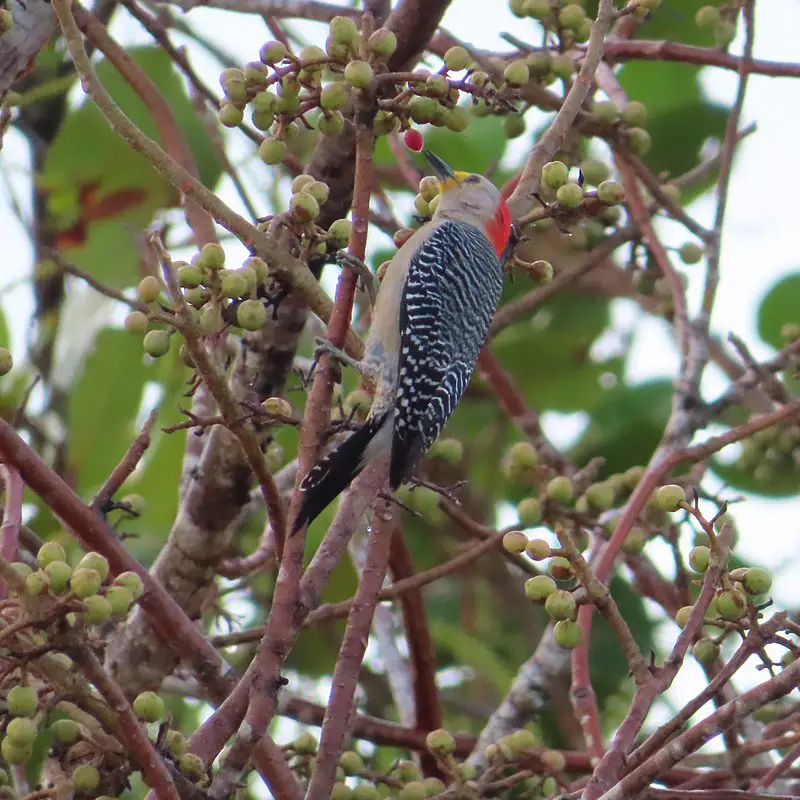
The Yucatan woodpecker is a species of bird in the family Picidae, commonly referred to as the red-vented woodpecker. It can be found from Belize and Mexico across the entire Yucatán Peninsula.
Its natural habitats are subtropical or tropical dry forests, shrubland, and even heavily degraded former forest areas.
Adults typically have a black back with white barring on both sides of their wings; they also possess a distinctive crimson patch at their lower belly area which gives them their “red-vented” name.
They mainly feed off insects that inhabit dead trees but may also eat fruits during different times of year when available.
The Yucatan Woodpecker has an important role in its ecosystem by helping disperse seeds through propagating fruit plants while searching for food sources within tree trunks – this helps maintain healthy populations of native vegetation throughout its range.Scientific classification:
| Kingdom | Animalia |
| Phylum | Chordata |
| Class | Aves |
| Order | Piciformes |
| Family | Picidae |
| Genus | Melanerpes |
| Species | M. pygmaeus |
Also Featured In: Most Common Birds You’ll Find in Quintana Roo, Cozumel Birds You Didn’t Know
34. Rufous Sabrewing
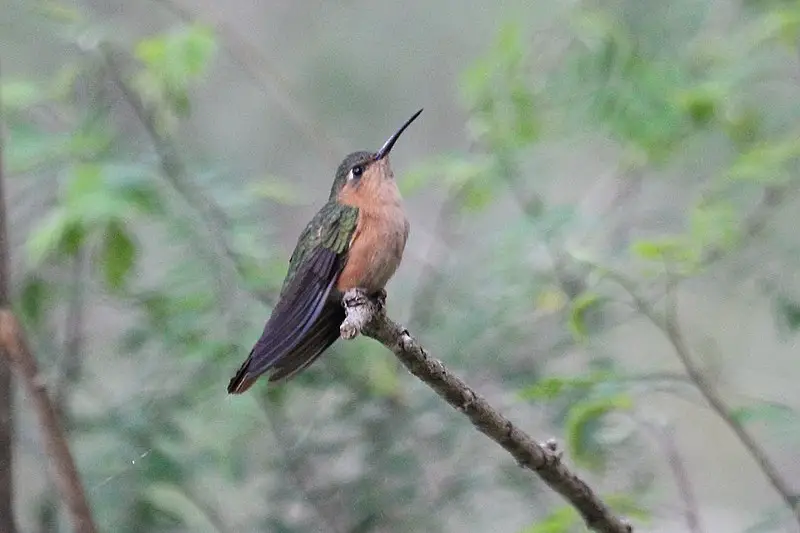
The Rufous Sabrewing is a species of hummingbird that can be found in El Salvador, Guatemala and Mexico. With its distinctive rufous-coloured plumage, this bird has an impressive wingspan measuring up to 19 cm.
This species feeds mainly on small insects such as midges, flies and spiders along with the nectar from flowers. The Rufous Sabrewing nests in low vegetation near streams or rivers and lays two white eggs per clutch during breeding season.
These birds are very territorial when defending their mating area which makes them one of the most beautiful yet aggressive songbirds out there.Scientific classification:
| Kingdom | Animalia |
| Phylum | Chordata |
| Class | Aves |
| Order | Apodiformes |
| Family | Trochilidae |
| Genus | Pampa |
| Species | P. rufa |
35. Mimid
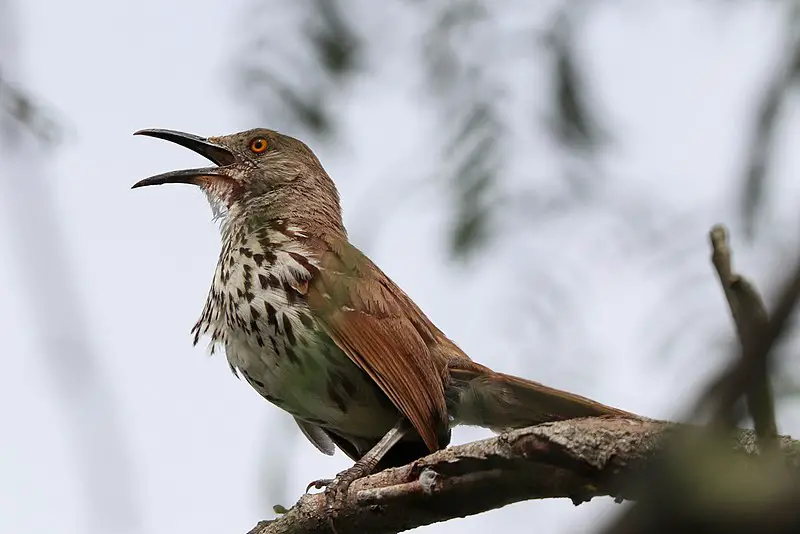
Mimid birds are a diverse family of passerines found in the New World. They have an impressive vocal range and many species excel at mimicking other bird songs, as well as noises from their environment.
Mimids can be identified by their flat heads with short crest feathers, long tails, large eyes and strong legs for hopping between branches.
These birds typically inhabit open woodlands or scrubland areas where they feed on insects such as beetles, caterpillars and grasshoppers.
Some species also supplement their diet with fruits or grains when available. While most do not migrate far during winter months some may undertake longer migrations to warmer climates if necessary to survive cold weather spells.
The wide variety of sounds these talented singers produce make them one of nature’s great musical performers.Scientific classification:
| Kingdom | Animalia |
| Phylum | Chordata |
| Class | Aves |
| Order | Passeriformes |
| Superfamily | Muscicapoidea |
| Family | Mimidae Bonaparte, 1853 |
Also Featured In: Birds that You’ll Find in Puerto Rico, Most Common Lake Birds
36. Gnatcatcher
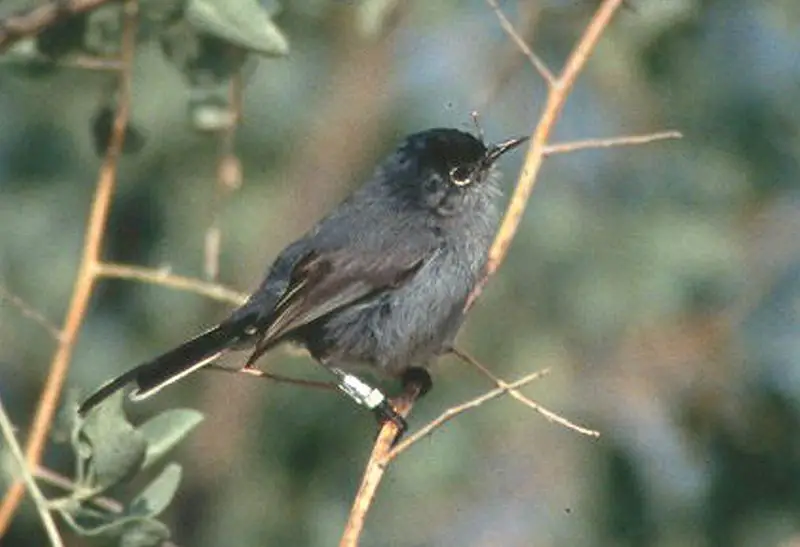
Gnatcatchers are small passerine birds from the family Polioptilidae. They inhabit North and South America, apart from far south regions and high Andean areas.
Most species of this mostly tropical and subtropical group remain in one area year-round; however, the blue-grey gnatcatcher of U.S.A and Canada migrate to warmer climates during wintertime.
Gnatcatchers share a close relation with wrens.[1] The size varies between 5–7 inches long depending on specie, they typically have dark upperparts while their underparts range in color: white or greyish shades may predominate but some species show yellow tinting too.
Their diet consists mainly insects which is usually captured by short sallies above vegetation level when foraging for food.Scientific classification:
| Kingdom | Animalia |
| Phylum | Chordata |
| Class | Aves |
| Order | Passeriformes |
| Superfamily | Certhioidea |
| Family | Polioptilidae Baird, 1858 |
Also Featured In: Birds that Live in Newfoundland and Labrador, Small Birds that Commonly Found in Ohio
37. Green-Throated Mountaingem
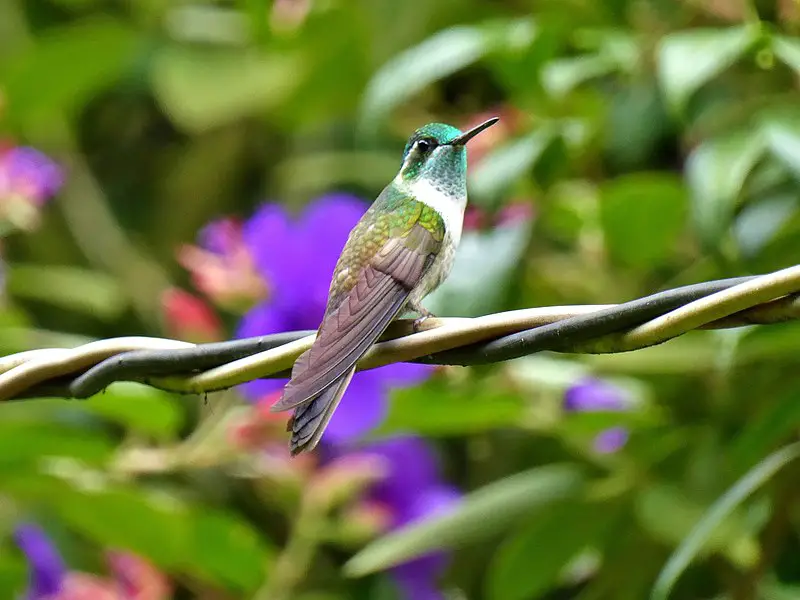
The Green-throated Mountaingem is a hummingbird found in El Salvador, Guatemala, Honduras and Mexico. With its bright green throat and shimmery wings of blue, black and purple feathers this beautiful bird stands out among the others.
Its close relative the Green-breasted Mountaingem has often been confused for it due to similar features. The species lives in mountain forests where they feed on small insects such as spiders or aphids and nectar from flowers like heliconias or bromeliads.
They are quite agile fliers with their short bills allowing them to hover while feeding with ease. This species nests near streams between April – August typically laying two eggs per clutch which hatch after 2 weeks of incubation by both parents who also care for their chicks until they fledge around 21 days later.
Overall these birds provide an incredible sight amongst tropical forest environmentsScientific classification:
| Kingdom | Animalia |
| Phylum | Chordata |
| Class | Aves |
| Order | Apodiformes |
| Family | Trochilidae |
| Genus | Lampornis |
| Species | L. viridipallens |
38. Bushy-Crested Jay
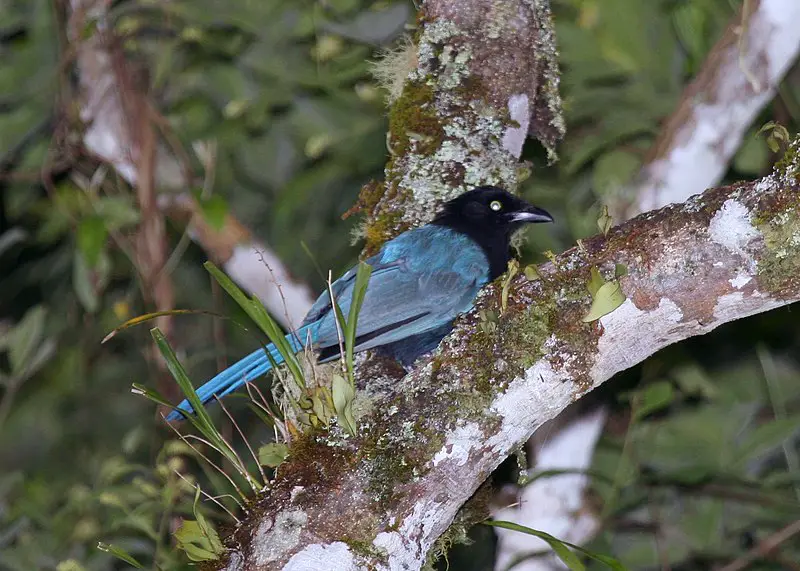
The Bushy-crested Jay is a species of bird found in Central America. It has two distinct subspecies, C. m. melanocyaneus located in Guatemala and El Salvador, and C.
m. chavezi which can be seen from Honduras to northeastern Nicaragua . This jay prefers moist montane forests or degraded former forest habitats as their home range .
They have an overall blue plumage with light gray underparts while the crest on its head is chestnut brown that contrasts greatly against its otherwise colored body.
The tail feathers are often barred black and white , giving it a unique look amongst other birds of similar size and coloration .
Their diet consists mostly of insects but they’ve been known to feed on fruits as well when available leading them to becoming seed dispersers for certain plant life throughout their habitat area.
All in all this species remains relatively common even though there may be some localized threats present due to deforestation activity happening within parts of Central America at timesScientific classification:
| Kingdom | Animalia |
| Phylum | Chordata |
| Class | Aves |
| Order | Passeriformes |
| Family | Corvidae |
| Genus | Cyanocorax |
| Species | C. melanocyaneus |
39. Potoo
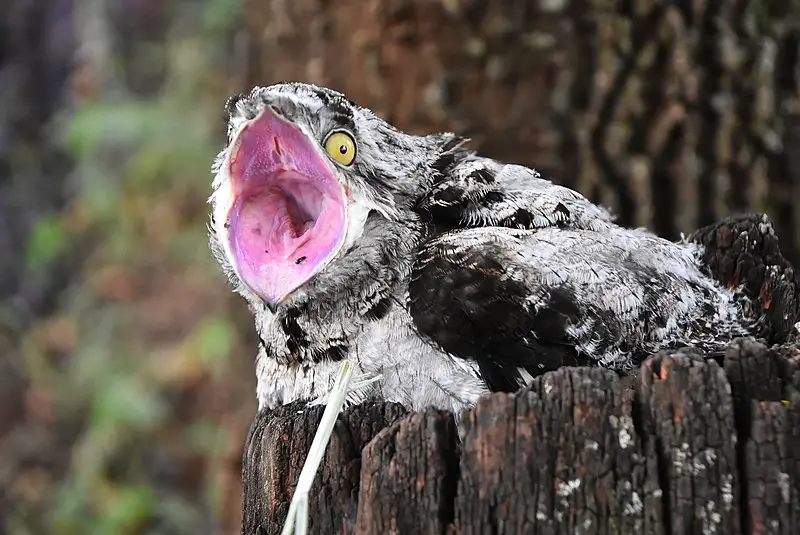
Potoo birds, or Nyctibius, are nocturnal creatures in the family of Nyctibiidae. They have a distinct long beak and large eyes that help them find prey during night time hunting.
These interesting-looking birds build their nests on tree branches near water sources such as rivers and lakes for easy access to food.
Potoos also use camouflage to blend into their surroundings when sleeping during the day; this helps protect them from predators like hawks who can spot an easily visible bird from miles away.
Potoos live in tropical regions throughout Central America and South America where they hunt small insects at night with their sharp sense of hearing allowing them to quickly locate hidden prey even in darkness.Scientific classification:
| Kingdom | Animalia |
| Phylum | Chordata |
| Class | Aves |
| Order | Nyctibiiformes |
| Family | Nyctibiidae |
| Subfamily | Nyctibiinae |
| Genus | Nyctibius Vieillot, 1816 |
40. Slaty-Tailed Trogon
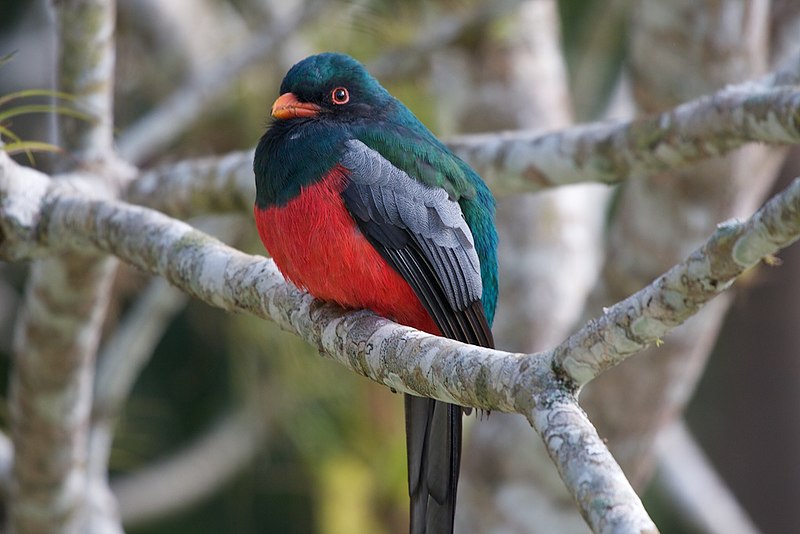
The Slaty-tailed Trogon is a medium sized bird that can be found in Mexico, Central America, Colombia and Ecuador. It has three subspecies – the nominate T.
m. massena, T. m Hoffmannni and T Austrialis which have sometimes been treated as separate species from the Black tailed trogon family instead of its own subspecies due to their distinct physical traits such as size differences or color variations like head feathers with darker shades than usual for the slaty tailed variety.
The wingspan of this beautiful bird ranges between 29cm – 34 cm while they weigh around 85g – 111g on average depending upon gender and other factors making them quite light weight compared to most birds in similar size range.
They also possess unique features such as long scaly tails at backside giving them an impressive look when soaring up high into sky.Scientific classification:
| Kingdom | Animalia |
| Phylum | Chordata |
| Class | Aves |
| Order | Trogoniformes |
| Family | Trogonidae |
| Genus | Trogon |
| Species | T. massena |
41. Woodcreeper
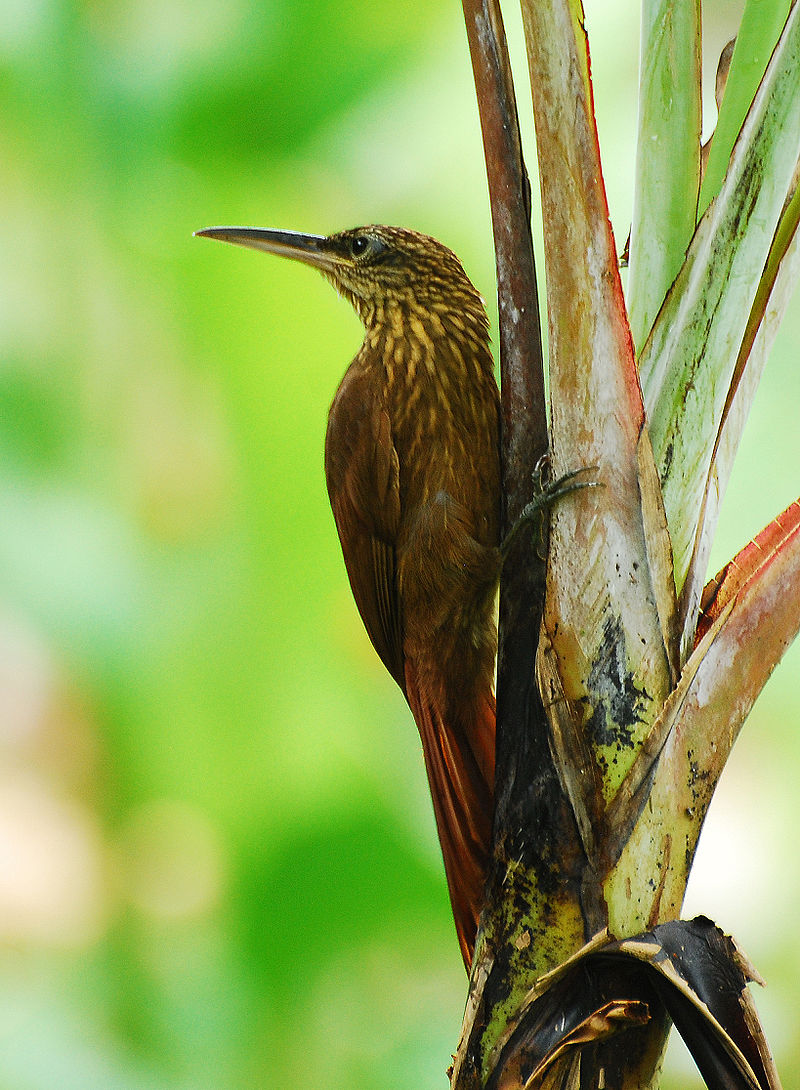
Woodcreepers are a subfamily of birds found only in the Neotropics. These unique creatures have traditionally been regarded as their own family, but now they are considered part of the Furnariidae ovenbird group.
With many species presenting resemblances to Old World treecreepers, woodcreepers can be identified by their long sharp bills and curved talons that allow them to climb up vertical surfaces such as trees with ease.
Their diet consists mainly of insects and other arthropods which they search for while clinging onto bark using both feet and tail feathers for support.
Woodcreeper nests typically line cavities inside trees or rock crevices providing good insulation from predators due to hard-to-reach locations; additionally, some species construct intricate mud tunnels leading into these areas for added safety measures.Scientific classification:
| Kingdom | Animalia |
| Phylum | Chordata |
| Class | Aves |
| Order | Passeriformes |
| Family | Furnariidae |
| Subfamily | Dendrocolaptinae |
42. Buff-Bellied Hummingbird
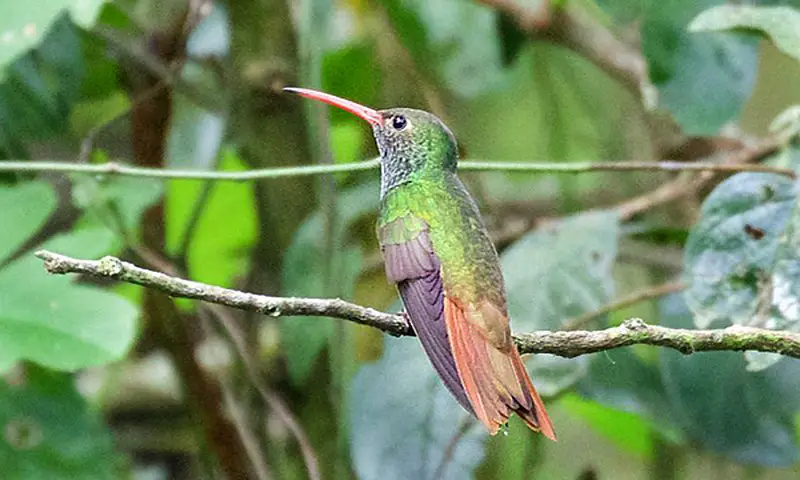
The Buff-bellied Hummingbird is a species of hummingbird belonging to the Trochilini tribe and found in Central America and parts of the United States.
It has three subspecies: A. y. yucatanensis, A. y chalconota, and A.y cerviniventris whose length ranges from 3.9 – 4 inches (10 – 11 cm).
The buff-bellied hummingbird’s plumage is mainly grey with greenish reflections on its back while it sports a distinctive buff colored belly which gives this species its name.
Its diet consists mostly of nectar as well as small insects; they often feed upon flowers near rivers or other bodies of water where their preferred food sources are plentiful.
In addition to being quite beautiful birds, these delightful creatures also possess an impressive ability for hovering flight making them one of nature’s most graceful avian wonders.Scientific classification:
| Kingdom | Animalia |
| Phylum | Chordata |
| Class | Aves |
| Order | Apodiformes |
| Family | Trochilidae |
| Genus | Amazilia |
| Species | A. yucatanensis |
Also Featured In: Birds You’ll Find in South Texas , Birds You’ll Find in the Rio Grande Valley
43. Buff-Collared Nightjar
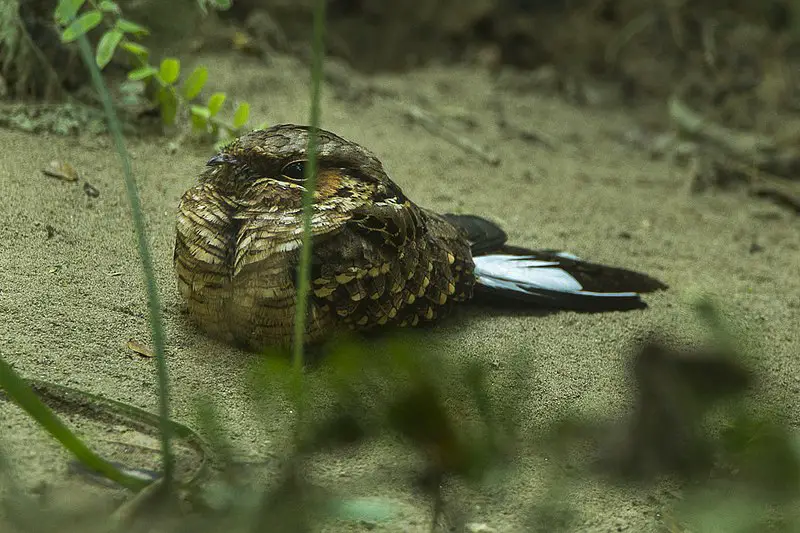
The Buff-collared Nightjar is a species of nightjar found in parts of Central America and the southwestern US. Its scientific name is Antrostomus ridgwayi, named after ornithologist Robert Ridgway.
It has two subspecies; A. r.ridgwayi and A.r troglodytes which were once included in genus Caprimulgidae due to their similar features with other nightjars from this family such as having long wings and tails for soaring at high altitudes over open areas during migrations or hunting prey like moths, beetles, crickets etc .
The buff-collar on its chest allows them to camouflage easily among tree branches helping it blend into its surroundings while roosting during daytime hours making them difficult to spot by predators or humans alike.Scientific classification:
| Kingdom | Animalia |
| Phylum | Chordata |
| Class | Aves |
| Order | Caprimulgiformes |
| Family | Caprimulgidae |
| Genus | Antrostomus |
| Species | A. ridgwayi |
44. Blue Bunting
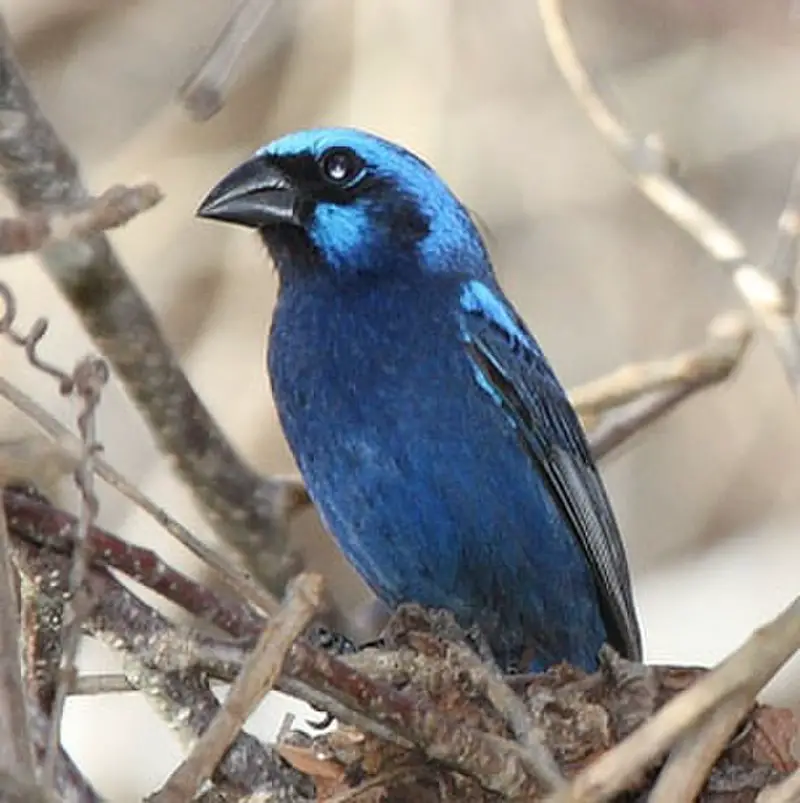
The Blue Bunting (Cyanocompsa parellina) is a colorful species of passerine bird belonging to the family Cardinalidae. It can be found in Belize, El Salvador, Guatemala, Honduras, Mexico and Nicaragua.
French naturalist Charles Lucien Bonaparte first described it as Passerina Parellina in 1850 before German ornithologist Jean Cabanis defined its genus Cyanoloxia.
The male has striking blue feathers with dark brown wings and tail feathers while females are dull gray-brown overall but still show some blue on their upper part.
They mainly inhabit tropical woodlands where they forage for insects among low vegetation or even near human settlements.
As such they make an interesting addition to any backyard garden and will often visit feeders if provided with food sources like sunflower seeds or suet cakes.Scientific classification:
| Kingdom | Animalia |
| Phylum | Chordata |
| Class | Aves |
| Order | Passeriformes |
| Family | Cardinalidae |
| Genus | Cyanocompsa Cabanis, 1861 |
| Species | C. parellina |
45. White-Bellied Emerald
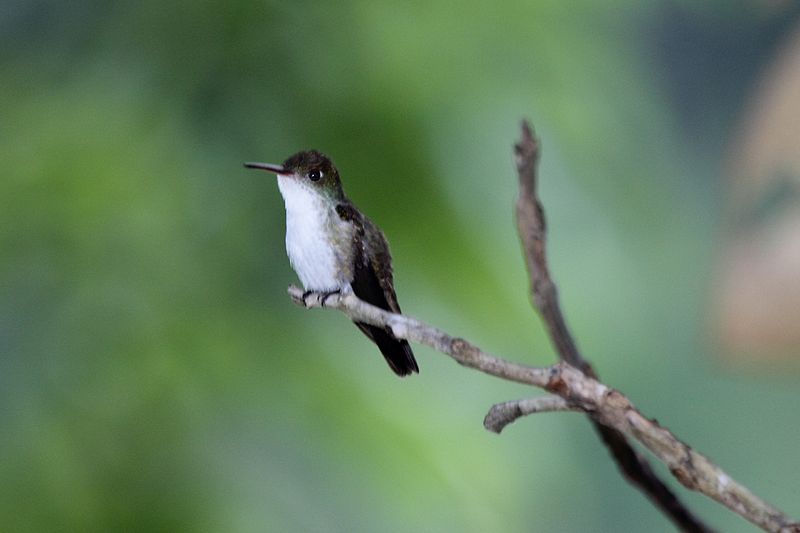
The White-bellied Emerald is a species of hummingbird found in Central American countries such as Belize, Guatemala, Honduras, Mexico and Nicaragua.
This small bird has an emerald green body with white bellies which makes it stand out in its natural habitat.
It was originally classified under the genus Amazilia but following a molecular phylogenetic study published in 2014 it was discovered that this genus is polyphyletic so now belongs to Chlorestes candida instead.
The White-bellied Emerald may not be the biggest or most colorful of birds but due to its unique markings and charming personality you can’t help admire it when seen flying gracefully through forests or meadows near riversides.Scientific classification:
| Kingdom | Animalia |
| Phylum | Chordata |
| Class | Aves |
| Order | Apodiformes |
| Family | Trochilidae |
| Genus | Chlorestes |
| Species | C. candida |
46. Black-Crested Coquette
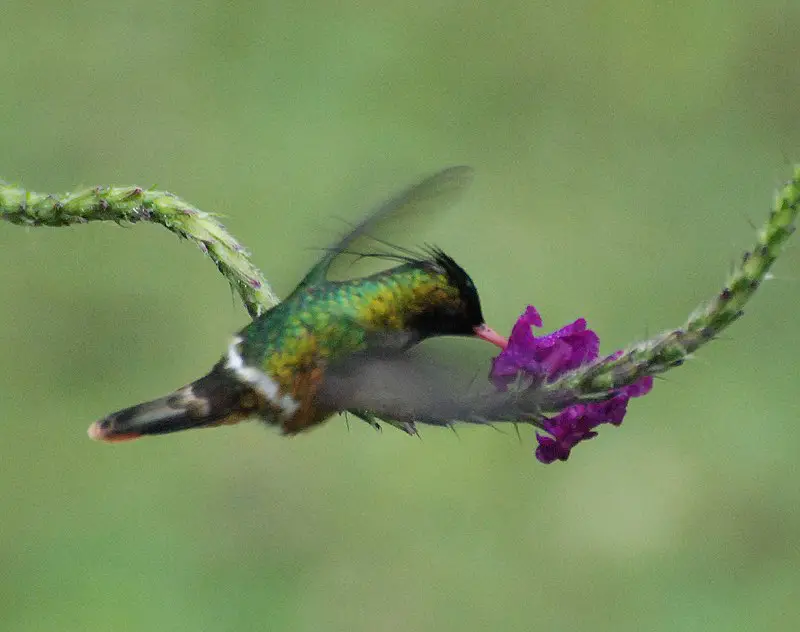
The Black-crested Coquette is a species of hummingbird that inhabits Belize, Costa Rica, Guatemala, Honduras, Mexico and Nicaragua. It has a striking black crest atop its small body which makes it easy to spot in the wild.
Its wings are short but powerful enabling it to hover over flowers while feeding on nectar with its long bill.
The male also performs elaborate courtship displays in order to attract female mates during breeding season by spreading an iridescent throat patch as well as doing aerial dives from high up above trees or shrubs.
This bird typically nests near low vegetation such as bamboo thickets due to their preference for staying close the ground so they can quickly take off if disturbed or threatened by predators or humans nearby.Scientific classification:
| Kingdom | Animalia |
| Phylum | Chordata |
| Class | Aves |
| Order | Apodiformes |
| Family | Trochilidae |
| Genus | Lophornis |
| Species | L. helenae |
47. Buffy-Crowned Wood Partridge
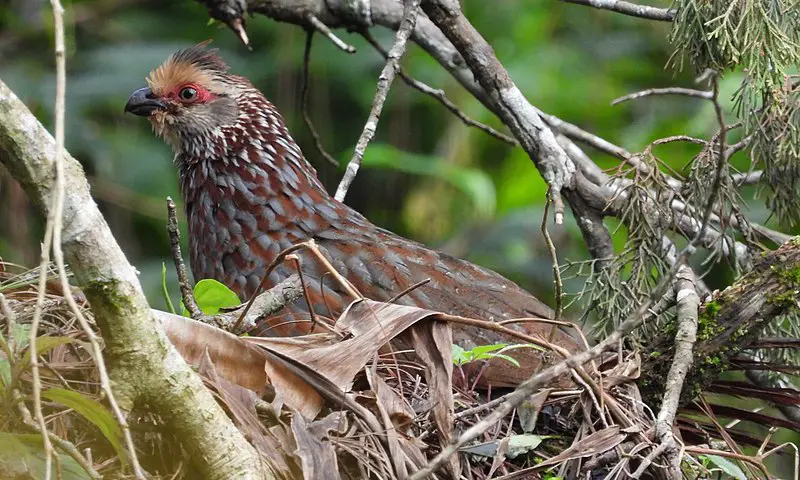
The Buffy-crowned Wood Partridge is a species of New World quail that can be found in Mexico, Guatemala, Honduras, El Salvador, Costa Rica and Nicaragua.
It was first discovered by Adolphe Delattre in Cobán, Guatemala back in 1843. Its unique features include its buffy crown feathers along with white spots on the belly and nape area.
In addition to this it also has long spurs which are used for protection against predators. The birds diet consists mainly of seeds but they will occasionally eat insects as well.
They prefer open areas such as pastures or grasslands where there is plenty of cover from tall vegetation so they can stay hidden from potential threats while still being able to spot their prey easily enough.Scientific classification:
| Kingdom | Animalia |
| Phylum | Chordata |
| Class | Aves |
| Order | Galliformes |
| Family | Odontophoridae |
| Genus | Dendrortyx |
| Species | D. leucophrys |
48. Bar-Winged Oriole
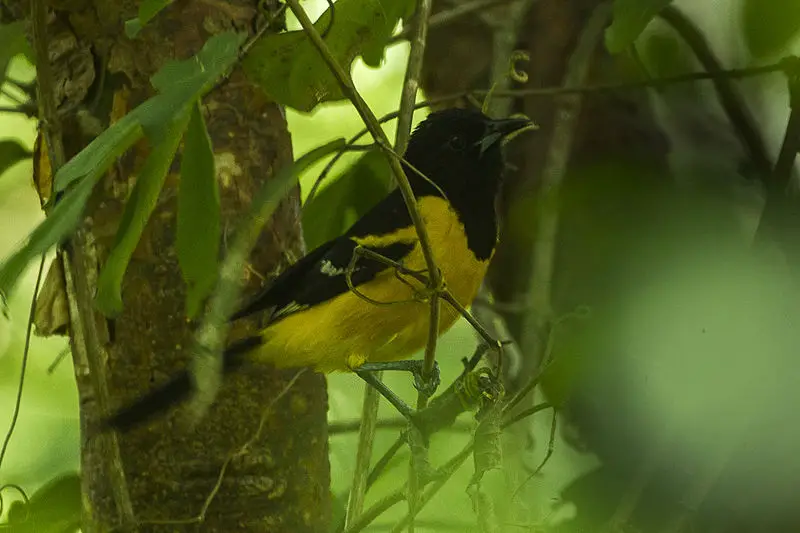
The Bar-winged oriole is a beautiful bird found in El Salvador, Guatemala, Honduras and Mexico.
It has distinctive black wings with white bars running across them from shoulder to tail feathers.
This species of bird prefers subtropical or tropical moist montane forests as its natural habitat but it can also be seen living in heavily degraded former forest areas too.
Its diet consists mainly of insects such as beetles and caterpillars which it finds on tree trunks and branches.
The Bar-winged oriole is an active forager that spends most days searching for food among the trees before returning to roost at nightfall.
Overall this lovely species adds beauty to these regions while helping maintain balance within their ecosystems by preying upon insect pests.Scientific classification:
| Kingdom | Animalia |
| Phylum | Chordata |
| Class | Aves |
| Order | Passeriformes |
| Family | Icteridae |
| Genus | Icterus |
| Species | I. maculialatus |
49. Black-Vented Oriole
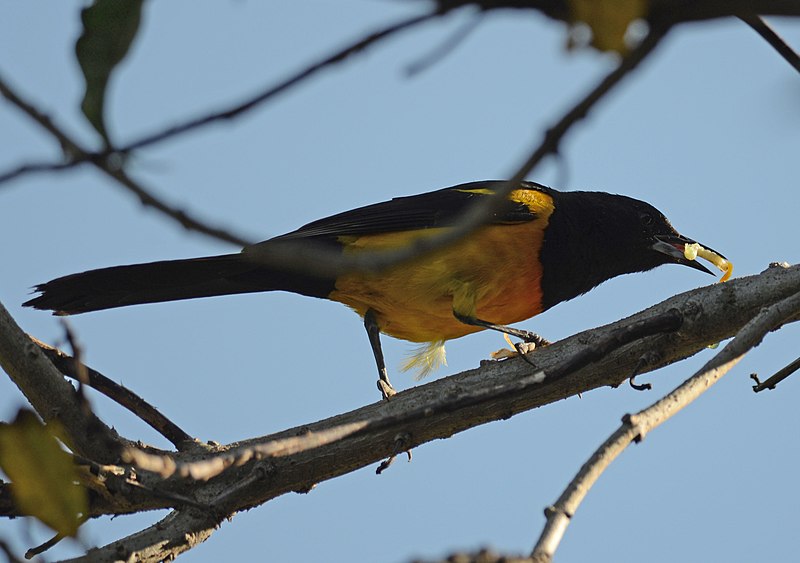
The Black-vented oriole is a striking species of bird that can be found in El Salvador, Guatemala, Honduras, Mexico, Nicaragua and the United States. It has black upperparts with yellow underparts and white wing spots on its wings.
The male also has an orange head patch while females have brown heads. This species prefers to live in dry or moist forests ranging from lowland to montane elevations.
They feed mainly on insects but may also eat some fruit such as berries or figs when available during certain times of year.
As they are quite active birds they require plenty of space which makes them ideal for larger aviaries if kept as pets.Scientific classification:
| Kingdom | Animalia |
| Phylum | Chordata |
| Class | Aves |
| Order | Passeriformes |
| Family | Icteridae |
| Genus | Icterus |
| Species | I. wagleri |
Also Featured In: Common Birds of Guerrero,
50. Barred Parakeet
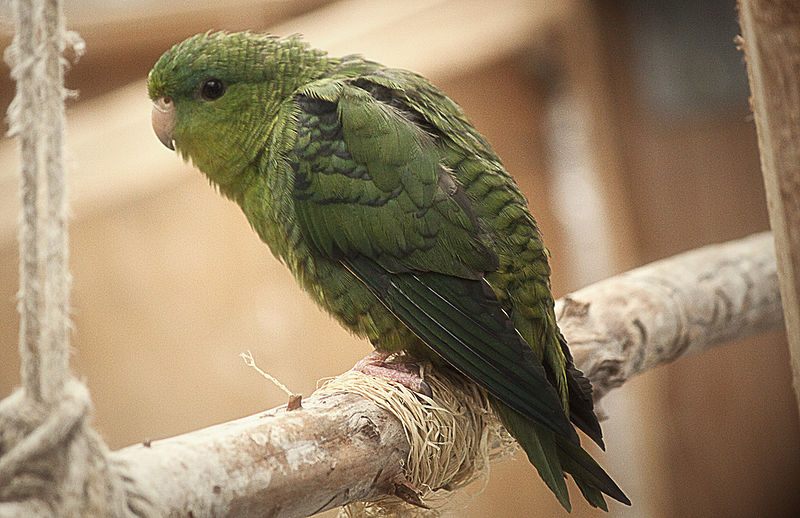
The Barred Parakeet is a vibrant and lively bird, commonly found in the highland forests of Mexico to Panama. It has beautiful green plumage with black and dark-green stripes running down its body.
Its distinctive long tail feathers have white tips that contrast nicely against its green background coloration.
Besides being an attractive species, it’s also active during the day, making short flights between trees or close to the ground foraging for food.
It feeds on fruits, nuts and other vegetation such as leaves and buds from various shrubs and trees which makes them important seed dispersers in their habitat range.
This adaptable parrot can be spotted in open woodlands as well as humid montane forest where they often flock together with other birds like macaws or toucans.Scientific classification:
| Kingdom | Animalia |
| Phylum | Chordata |
| Class | Aves |
| Order | Psittaciformes |
| Family | Psittacidae |
| Genus | Bolborhynchus |
| Species | B. lineola |
Also Featured In: Case Birds that Live in with Us,